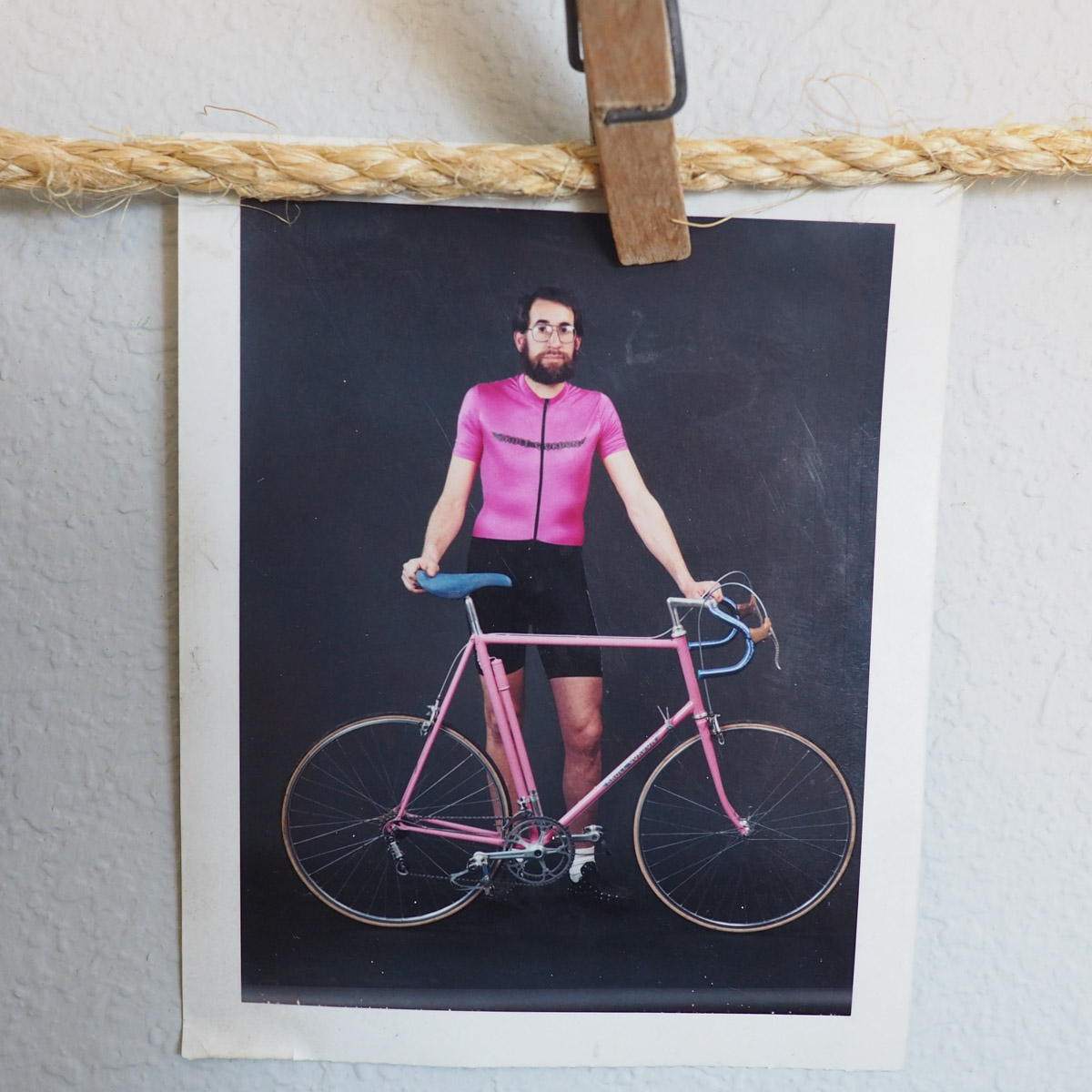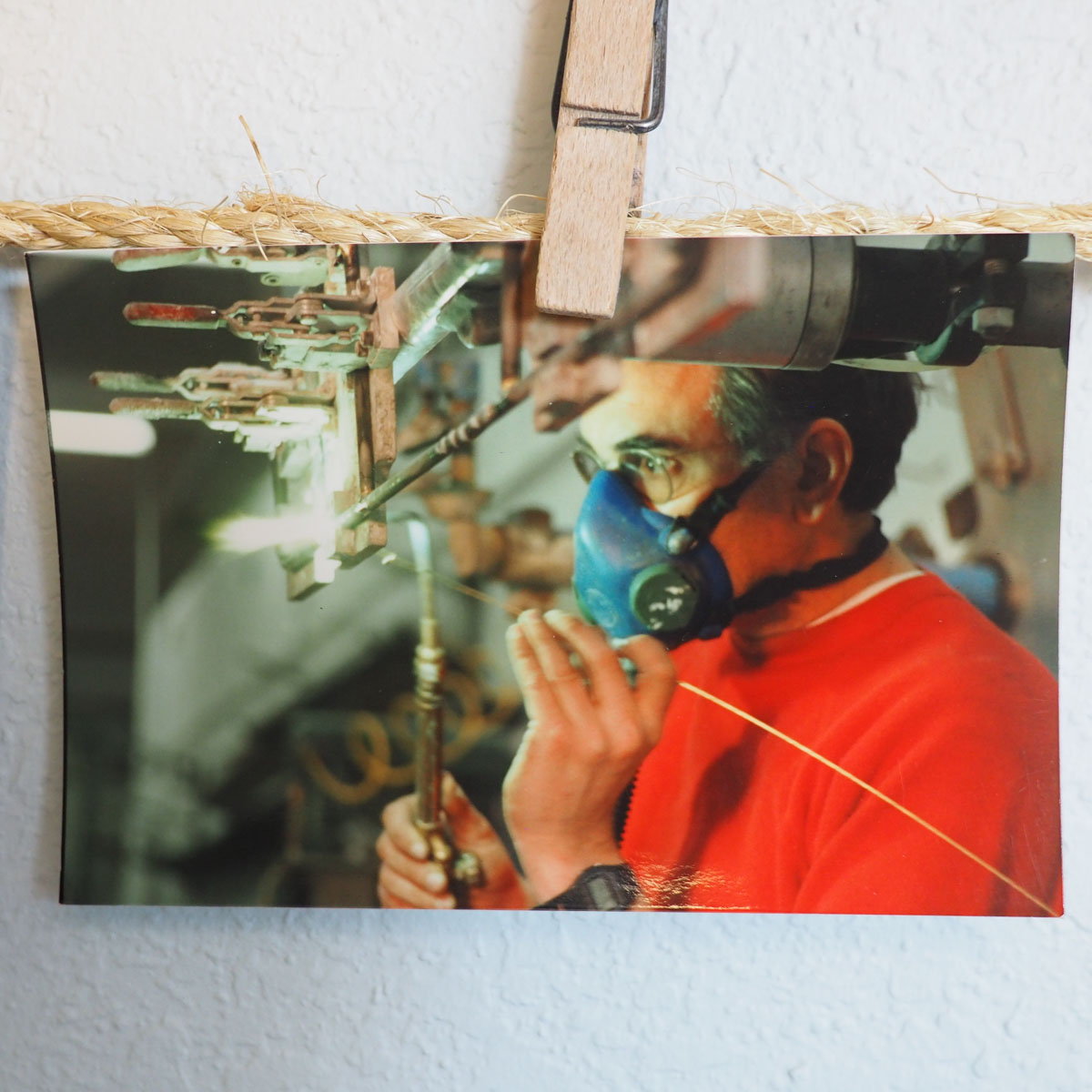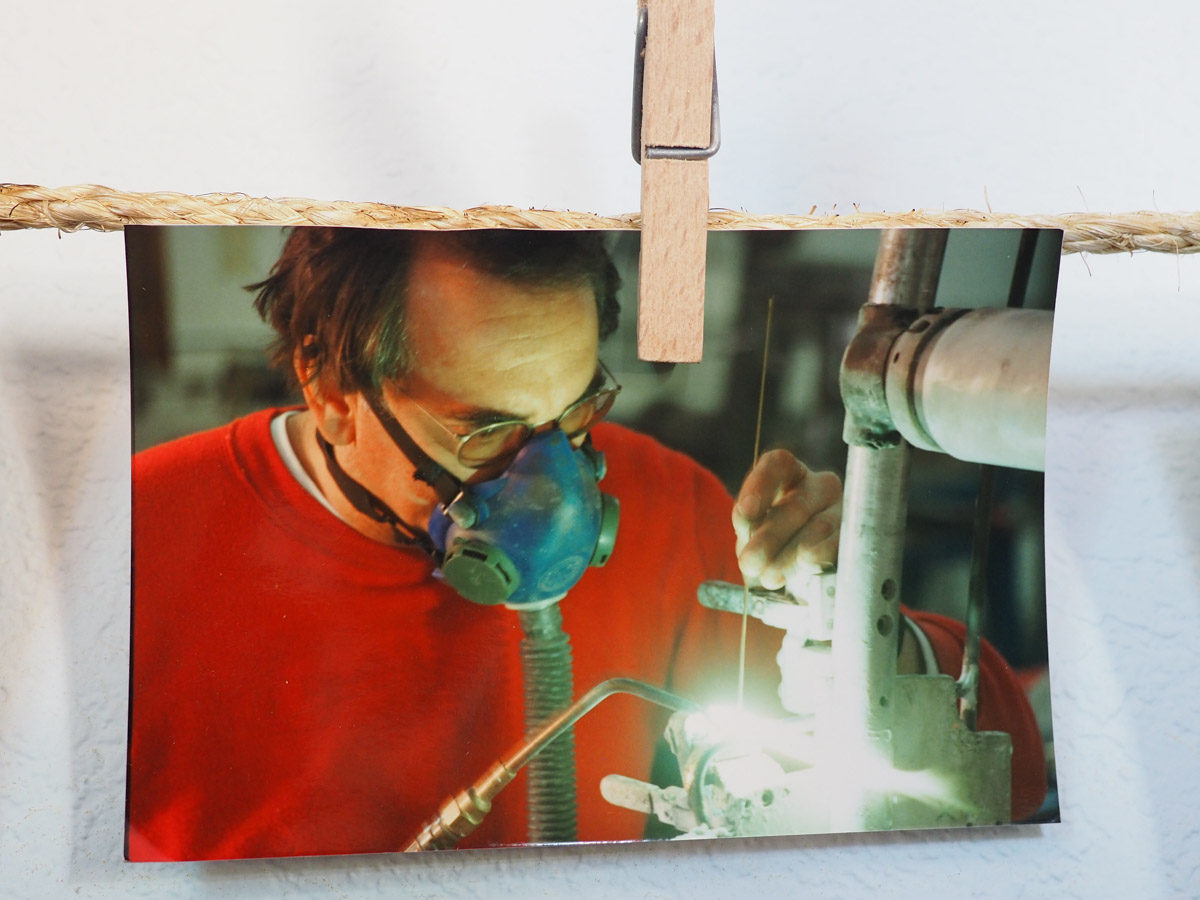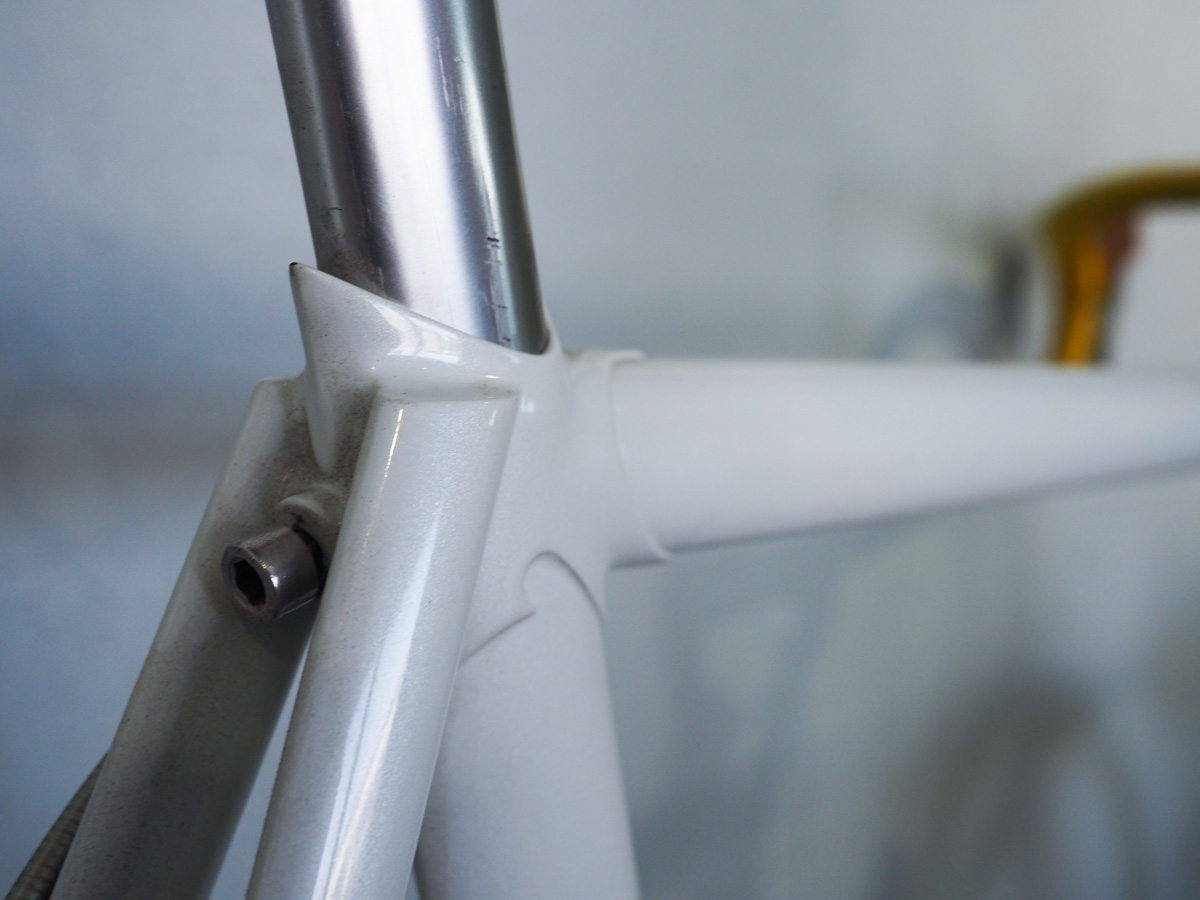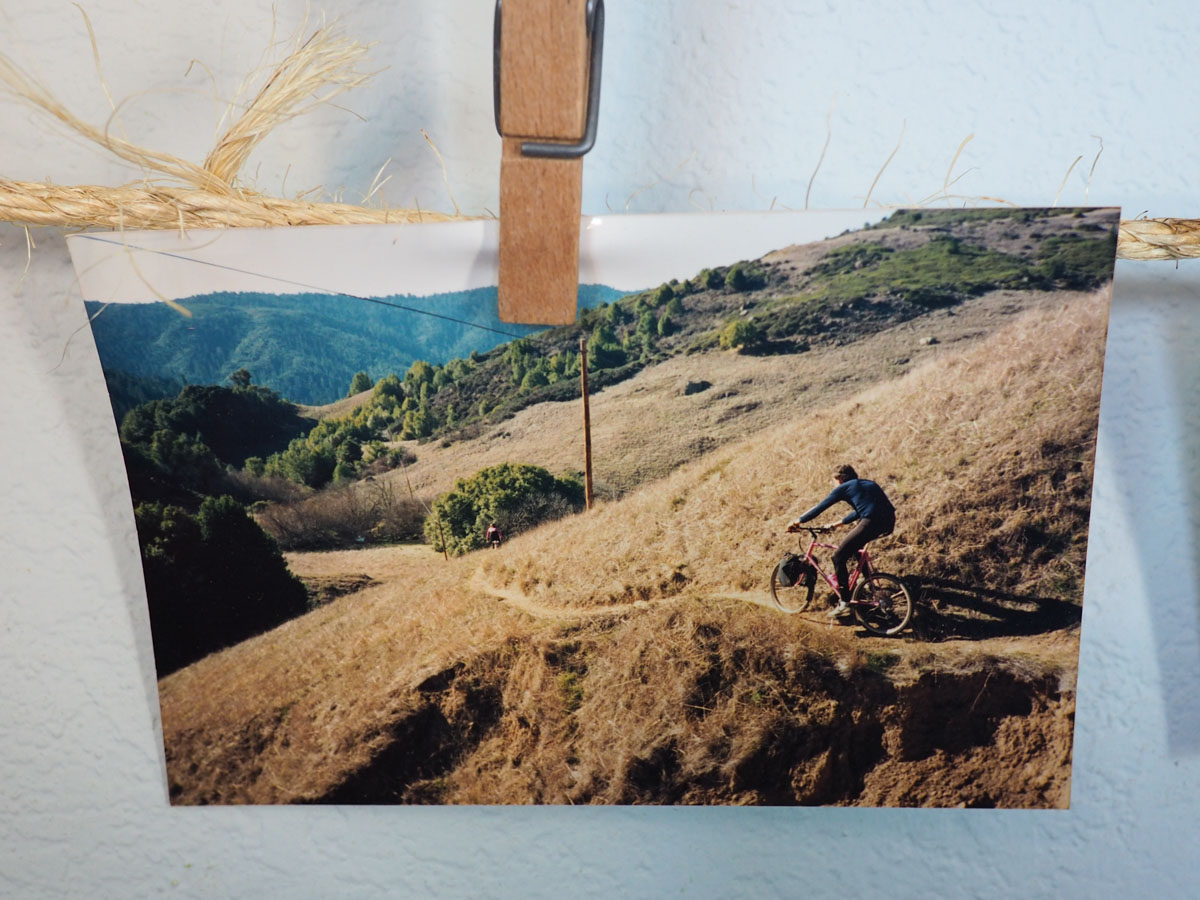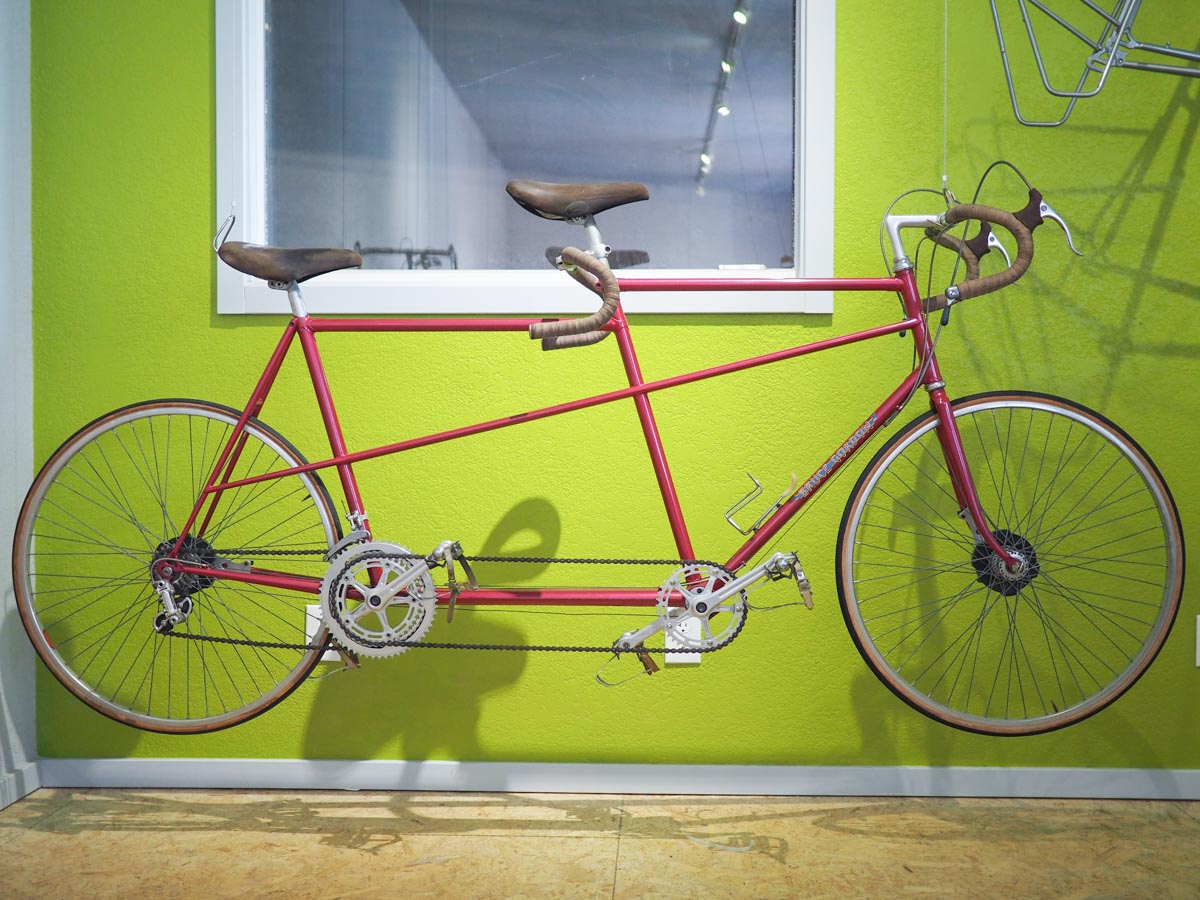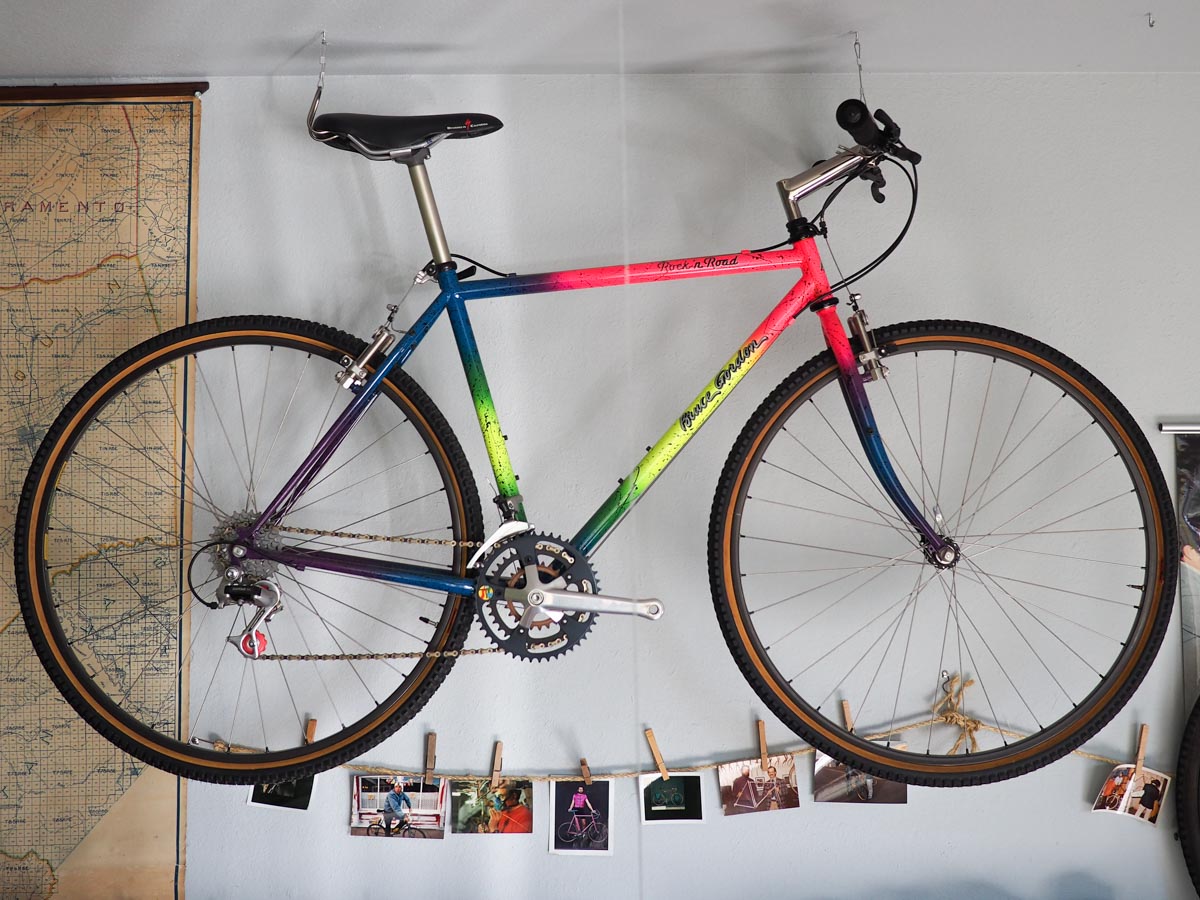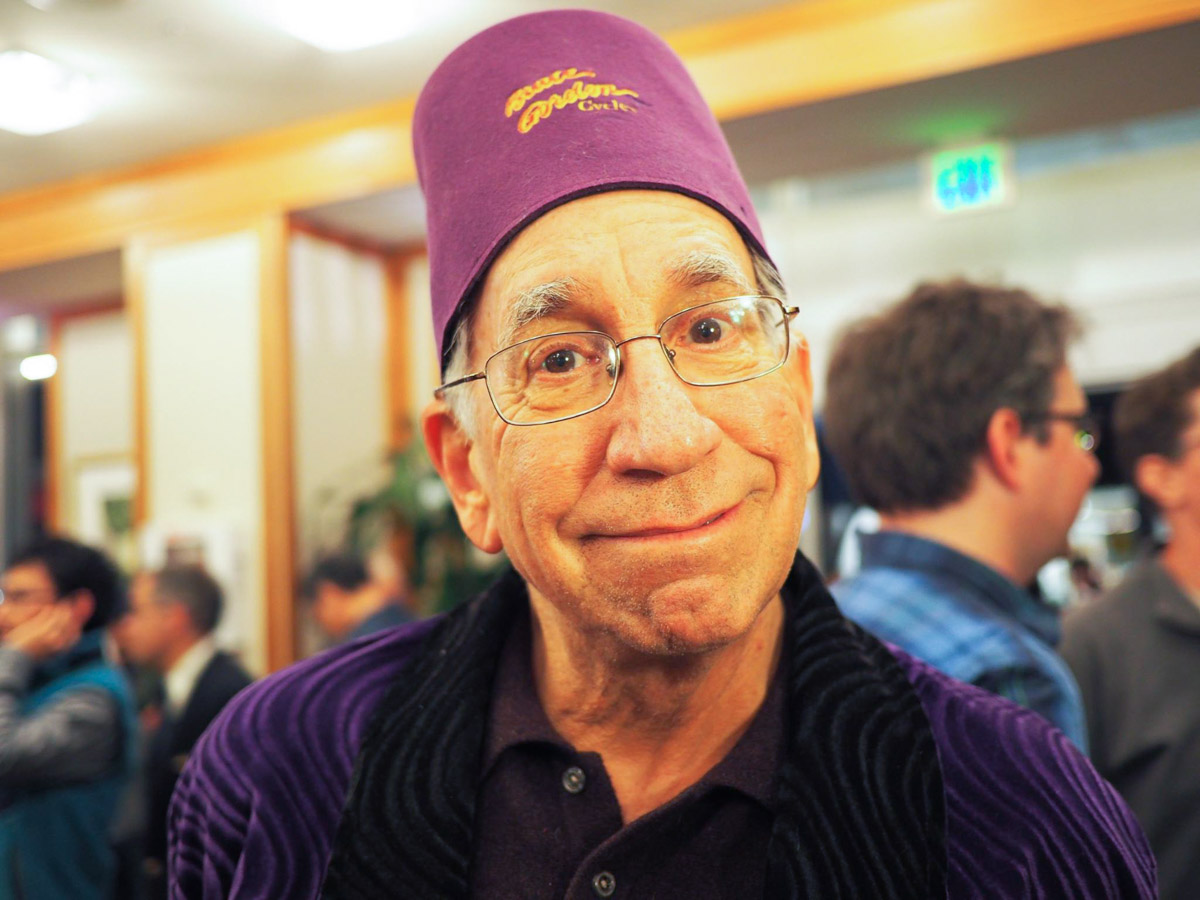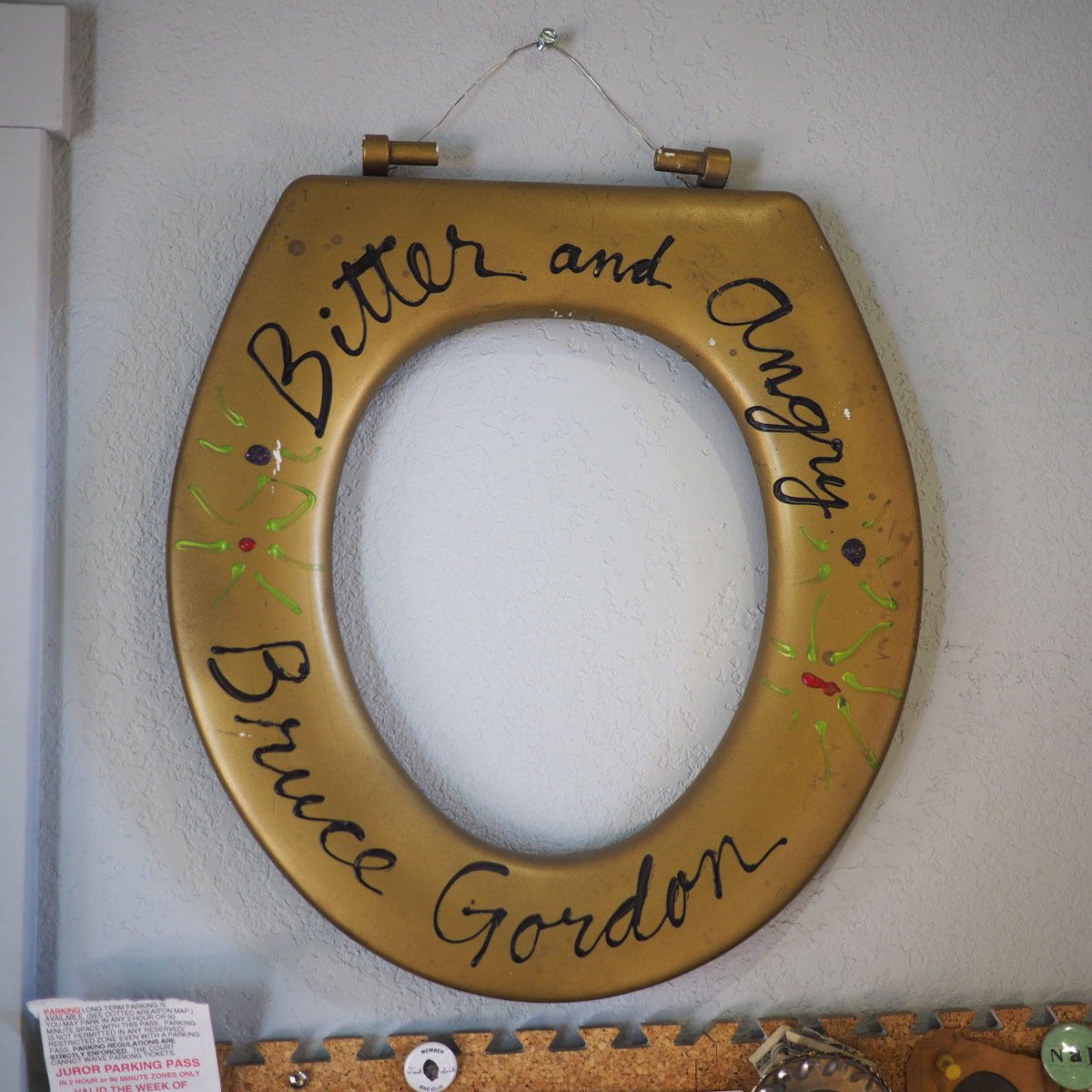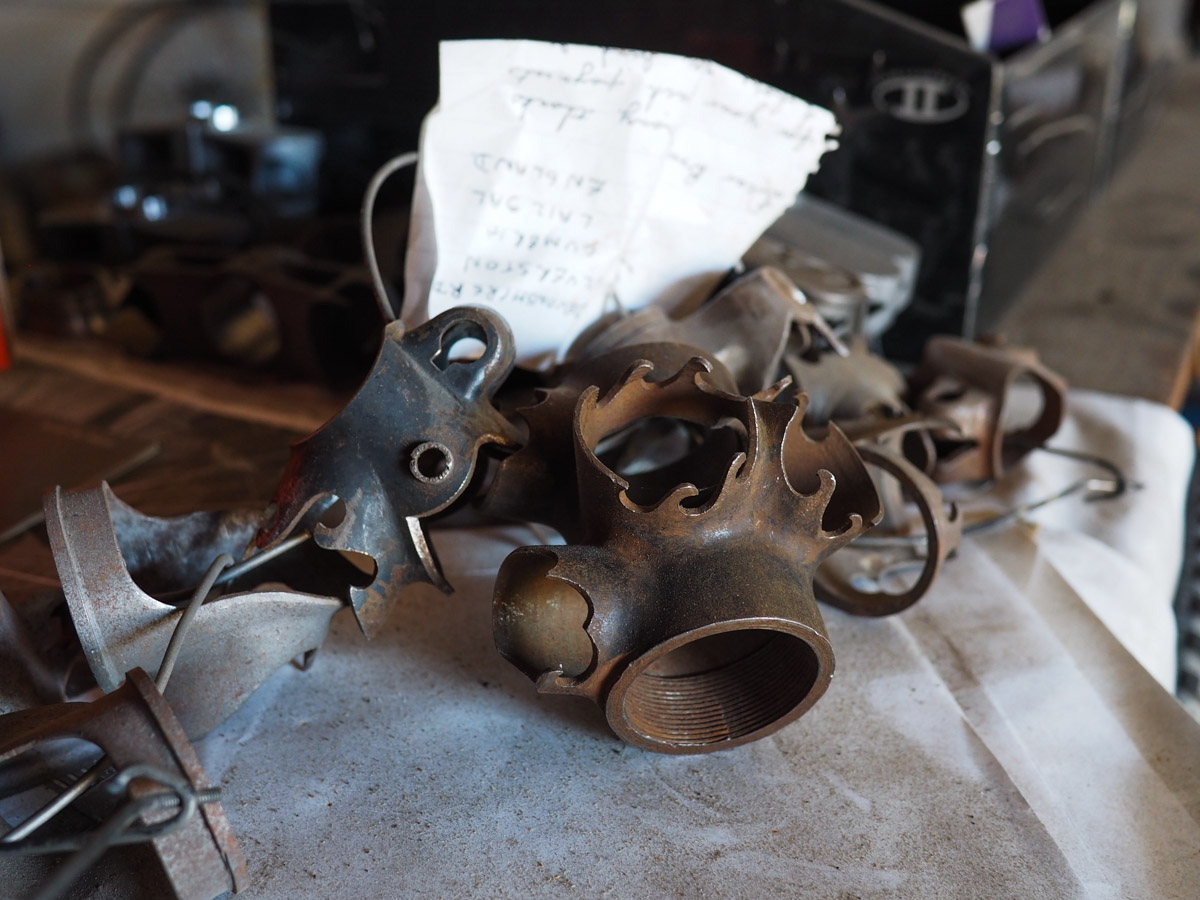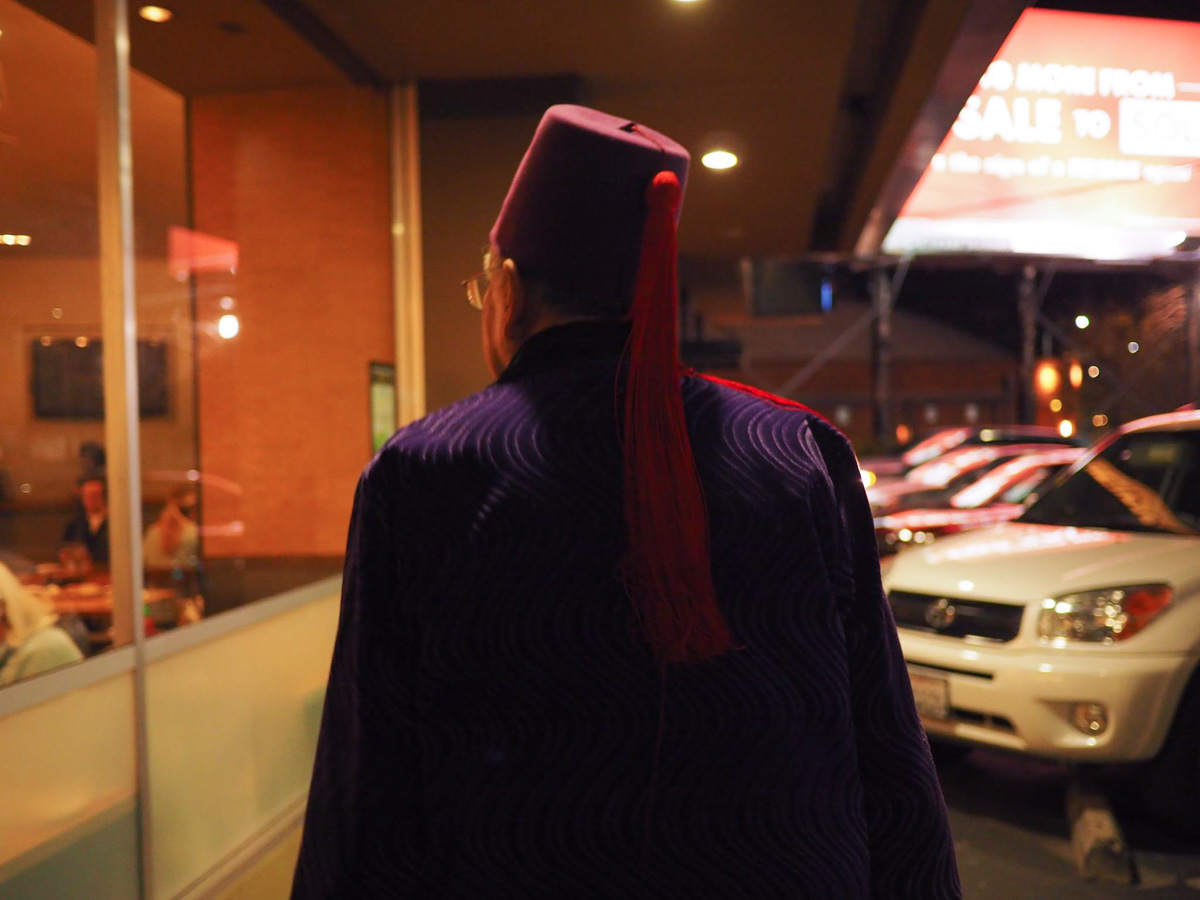We lost a hero to many in the cycling community yesterday. To celebrate his life, we are re-releasing Anna’s retirement interview with Bruce Gordon, originally published October 27th, 2017.
But first, a sentimental tribute to Bruce by one of his biggest fans.
My favorite Bruce Gordon experience was in 2016 at NAHBS in Sacramento.
Slogging my way from the show floor, brain busted from the BikeRumor rookie beat covering new builder row (which I crushed, by the way), I saw Bruce Gordon and Paul Sadoff (Rock Lobster) in the lobby of the show hotel. The two of them were exhibiting together as Schnozola – a joint endeavor between two old friends. Maybe eight bikes were made in all. Most of them were at the show.
Bruce was magnificent. He was beaming in his purple velvet suit jacket and the giant fez with the tassel down to his back. Paul called me over. They were going to the legendary SOPWAMTOS (Society of People Who Actually Make Their Own Shit) ceremony, which they had resurrected for that particular NAHBS. They wanted me to accompany them.
It was one of those weird moments where your Super Bicycle Industry Professional brain kind of switches off and you instantly regress to the awkward bike geek fankid you were before you joined the industry. These were folks that I had stalked in magazines and through the internet for many years – my rock stars. I loved their work. I’d only heard about SOPWAMTOS ceremonies – seen the awards all over the place in my travels. I’d always wanted to go to one and I thought I had missed my chance.
Bruce Gordon and Paul Sadoff want me to accompany them to SOPWAMTOS? Is this a dream? How exhausted am I?
Shit. Be cool, Anna.
Still in my regressed fankid state, I soon found myself in the way-back of a taxi van next to Tom Warmerdam of Demon Frameworks, another top builder and personal favorite whose work was (and still is) my favorite thing to fawn over online. Bruce wanted to go to IHOP on the way. Paul, on the other hand, was in frantic open rebellion at the idea. Tom and I were giggling in the back. Tom, I think, had also regressed. He is also a big fan of Bruce’s. It was surreal – Bruce in the jacket and fez in the front seat poking Paul, the bear, their legendary personalities reversed.
The ceremony started soon after we arrived at the venue – and that’s the point where my memory isn’t as sharp. I was exhausted and frankly overwhelmed by the strong good vibes coming at me from every direction. The place was packed with makers and diehard fans of makers. Stoke was highest.
What’s burned into my memory, though, was Bruce, the legendary curmudgeon, playing co-host of honor. Radiant and witty in his element.
A few months later, I landed in Petaluma to interview him. Bruce had requested that I fly out to talk to him in person. It sounded urgent on the phone. He wanted out of the industry. He was done. He was handing-off the business – or at least trying to.
We spent a weekend together, hanging out and talking about the world. Bikes. Industry. Stuff. I went through drawers and dug around his shop. It was amazing. There was art and process equipment. His bike showroom blew my mind – outstanding bike after outstanding bike. Every single bike there was a lot to take in and I spent a lot of time in there just absorbing each clever, beautiful, and perfectly executed feature.
I didn’t know what to do with all of it, or how to capture it and the myriad of stories he was telling as we went along. Conversation throughout was peppered with fatalistic comments and long, uncomfortable pauses. It’s no secret that Bruce battled with depression. He’d tell you so himself. It was clear he was hurting badly – even for Bruce. It was difficult to see.
The theme he kept returning to was that he wanted out because he didn’t want to become “one of those guys” you’d see watching from the back of the shop as their whole life’s work was auctioned off for pennies. I’d been to shop auctions. I knew exactly what he was talking about and I completely understood that fear.
The terrible elephant in the room the whole weekend was that that outcome, the one he was so terrified of, was an inevitability for him.
I think he knew it to a degree. While there had been a few folks he had worked with to hand off his business, none of those relationships stuck. Why would this one stick? Why would the next one stick?
It underscored one of the coldest, most uncomfortable truths about bicycles and the cycling industry: that people and product and media and the cycling experience are greatly undervalued – especially in the independent frame building community. It’s tough to make a living in those circumstances, with folks constantly questioning the value of your expertise and your product.
Insulting you, actively and passively, because they don’t understand or value you or what you create – Bruce had a lifetime of that under his belt. You could hear it in his voice when we dug into the real interview.
When I wrote in the introduction to the interview with Bruce that I couldn’t listen to the interview for a year, I meant it. It was intense to a point where it made me question myself and why I was doing what I was doing. I came home from that trip changed. Seeing the folder with the audio clips and photography used to give me pain in my chest, so I had to nest it in another folder for a year before I was actually ready to pull it out and transcribe and edit.
Here it is, one more time because Bruce Gordon of all people deserves an encore.
Cheers to you, Bruce. I appreciated you, your honestly, and your frankness. I love your work – it is brilliant and beautiful and nuanced. Thank you for giving me that brief and intense window into your world.
To say you were one in a million is a grave understatement.
And without further ado: that interview.
This was a difficult interview to put together for several reasons.
For one, as someone who has been an industry presence for over four and a half decades, Bruce Gordon is influential to a level that is impossible to capture adequately in a single piece. He has inspired scores of domestic framebuilders, including Paul Sadoff of Rock Lobster and Stephen Bilenky, to take up torch. The exceptional caliber and breadth of his work continues to set a bar for builders to aspire to and his early push into what would become 29er territory with his world famous Rock n’ Road tires and framesets shows a builder ahead of his time.
As a co-founder of SOPWAMTOS (Society of People Who Actually Make Their Own Shit), he has been a vocal and flamboyant critic of practices that he feels harm the bicycle as a machine such as outsourcing or simplifying product for better margins. This practice of challenging what many inside the industry perceive as the recipe for doing business has given him a rock star status in some circles and made him a pariah in others.
But really, this interview was challenging because while many interviews are about looking at the present and the future, this interview was done almost entirely looking to the past – and not with a lot of positive sentiment. Bruce was looking for a way to retire, trying every avenue that would allow him to avoid selling everything off. But prospects were not looking good.
Rather than cut this down to something easy, breezy, and palatable, I left everything nearly unedited so that the Chicago art student turned bike builder turned industry critic could speak for himself. Enjoy words straight from the Bruce’s mouth.
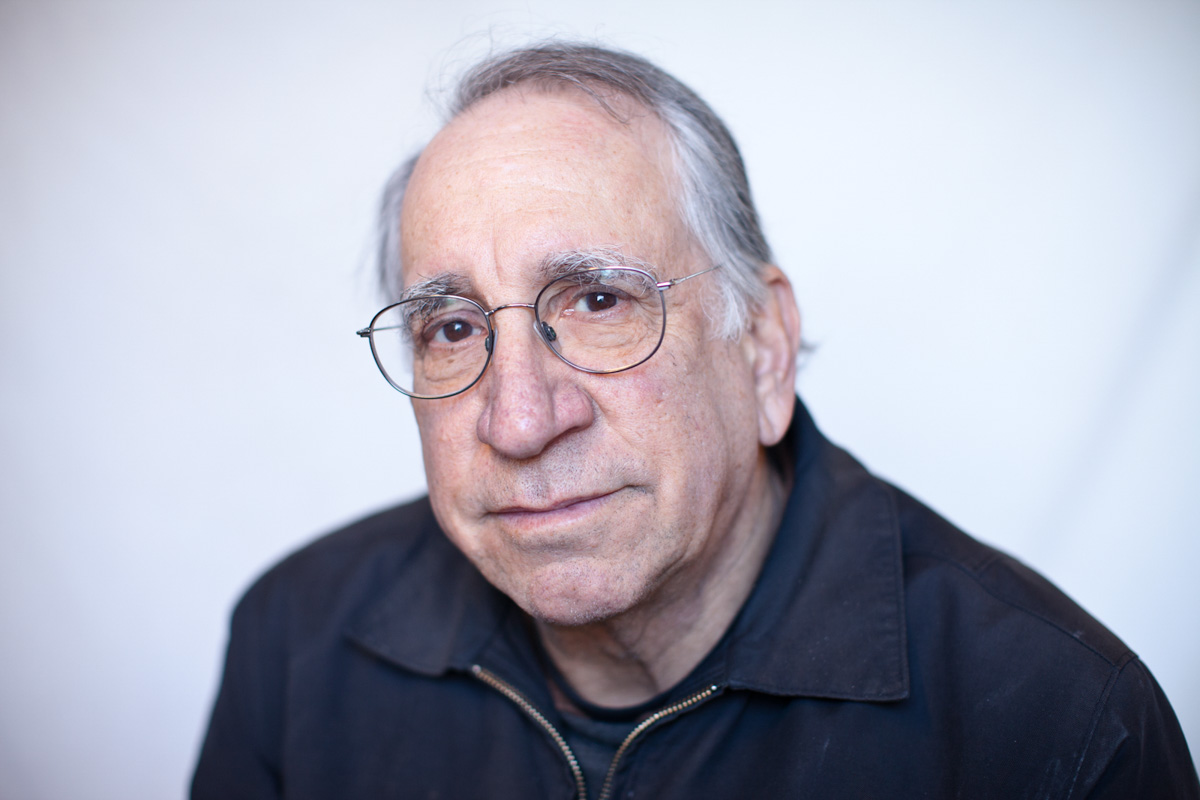
BIKERUMOR: You started in art, working on your masters at the Art Institute in Chicago. Within a few years, you were building bikes in California. What did that path look like?
BRUCE: I bought a Raleigh Grand Prix in 1970 when I dropped out of graduate school. Before that, I had Schwinn bikes. A friend of mine was living in Venice, so I moved to California.
I had a spiral bound notebook in which I wrote in pen, handwritten, a letter to Raleigh saying that I owned a Raleigh and really wanted to be a Raleigh dealer. I’m sure it’s still up at the Raleigh headquarters. It was really naive.
BIKERUMOR: “Dear Raleigh! My name is Bruce. I am twenty-four and a half years old…”
BRUCE: Exactly. “I own a Raleigh and I ride a Raleigh and it’s the best bike and I want to be a Raleigh dealer in LA somewhere.” I moved to Venice and worked for the Culver Bike Rack. It was owned by a guy who was a stuntman for the MGM Studios who did bull whips and axe throwing and whatever — this is what he did.
The bike shop he got into because his daughter had a boyfriend who wanted a bike shop. And then they broke up.
BIKERUMOR: And then he had a bike shop.
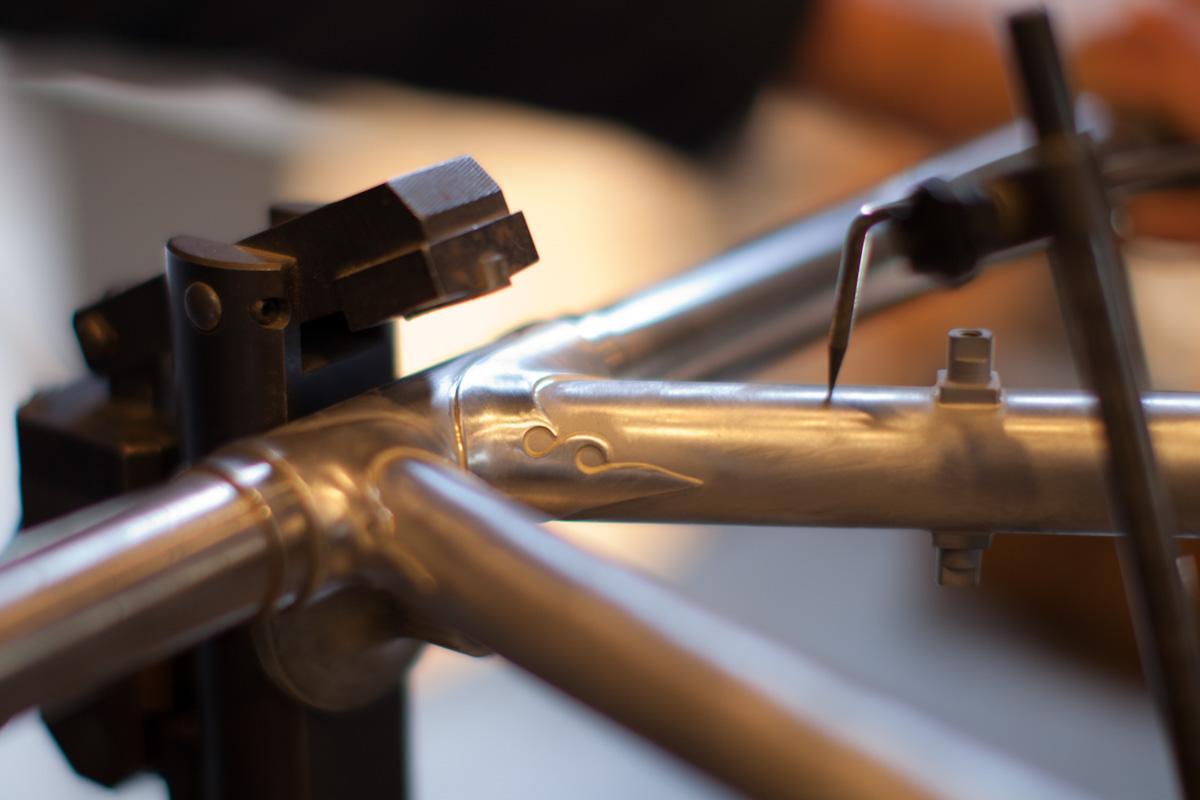
BRUCE: And then he had a bike shop. He didn’t understand that the boyfriend of the daughter had taken all the good parts out of the bike shop. I showed up and said “I’m here to work. I know about bikes.” I didn’t know relatively anything, but I bullshitted my way in there. Then he sold the business, finally, to an accountant from Beverly Hills. I think I was making six dollars an hour. The guy told me that he couldn’t afford to keep me. He drove a Mercedes and Cadillac. “I can’t afford to pay you six dollars an hour.”
Then I moved to Oakland/Berkeley area because I had another friend in Walnut Creek. And so I walked in what was College Avenue Cyclery. It was in Oakland. The manager was Elmer Bacciagaluppi. He had been in the bike industry a long time. They owned the Bank of America before it split up and became The Bank of America. He didn’t have any money. He hired me.
Then I met Albert [Eisentraut]. Albert was teaching classes.
BIKERUMOR: Both Chicago dudes on the West Coast.
BRUCE: Yes.
BIKERUMOR: Did you stick out? Did you notice each other for that?
BRUCE: No, no. Before that, I almost bought The Missing Link in Berkley. That was a cooperative that was on the campus originally. It was owned by the people who currently worked there. I showed up. I was a long haired hippie and I had $27,000…
BIKERUMOR: Wait, what kind of hippie were you that you were walking around with that kind of money?
BRUCE: And that was 1973. Yeah, so they never trusted me. So I went to a meeting. They said, “You may be a hippie and you may fit in, but how come you have so much money?”
After the Missing Link thing fell through, I went to work for Peter Rich. Peter offered me a job. I worked for Peter for two weeks before Albert’s class, with Joe Breeze and Danny Nall and all these guys. I was going to back to work for Peter, but I decided I really liked building. Albert was looking for money at that time. He had made forty bikes with six people— forty bikes a year.
BIKERUMOR: So not really an optimized operation.
BRUCE: And he didn’t have any machine tools— he had a lathe.
BIKERUMOR: What did the class look like? How many people? What was he teaching?
BRUCE: Maybe ten people. It was maybe ten days or two weeks. That was back in the days when we only used lugs. He would braze, “Okay, go at it.” Whereas when I taught the class, I would put my arms around them and hold the torch, but Albert didn’t want to do that.
I still have the book that Albert printed out. It was a pro forma thing. It was before computers. So it was all typed out by hand. Six columns of figures and pro forma invoices and pro forma data and pro forma revenues. It was a business plan. My father looked at it and said “You’re out of your fucking mind.” My father didn’t swear a lot.
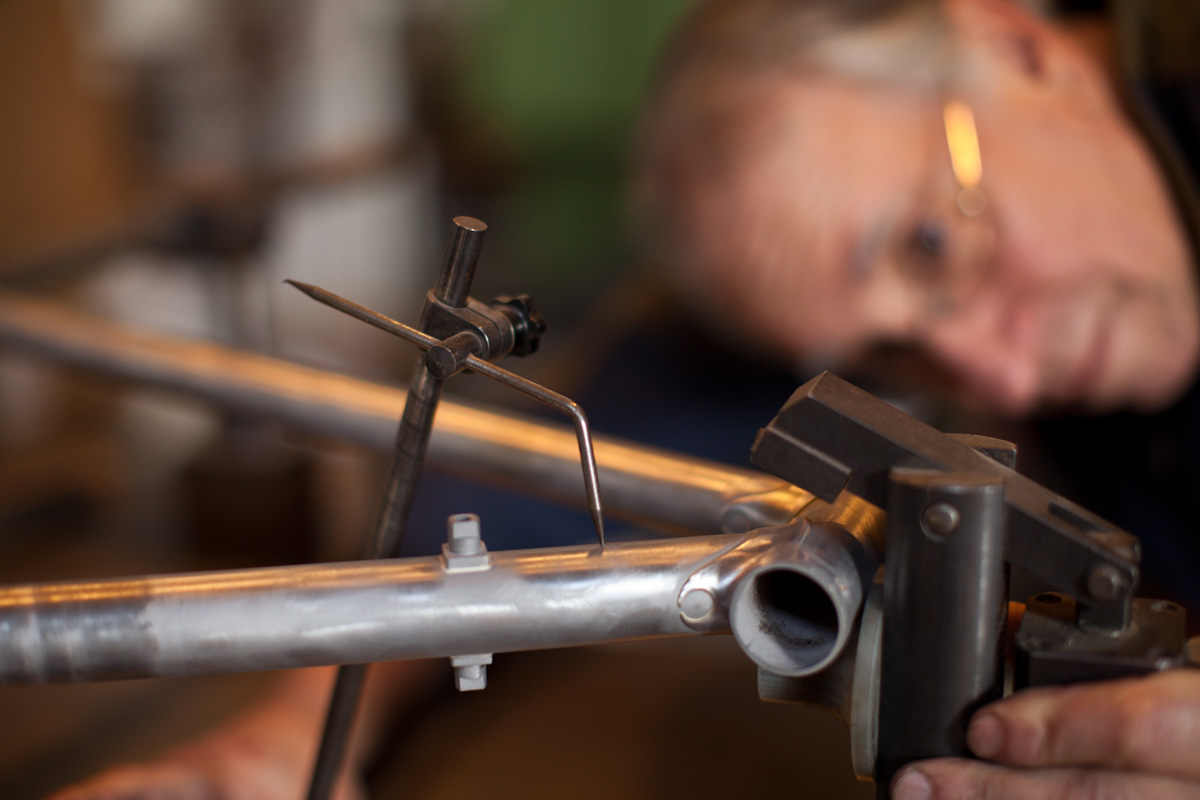
BIKERUMOR: But he swore about that.
BRUCE: He swore about that. I was the typical middle class kid from the seventies. My father and mother — my father was against it. My mother was, “Well, if that’s what makes him happy!” So I invested $27,000 in Eisentraut Bikes, which was a shitload of money in 1973.
BIKERUMOR: You learned only in lugs, ten people in the class. Joe Breeze was in the class. Did you know him ahead of time?
BRUCE: No, I didn’t know any of those people. I went into business— Mark Nobilette had taken the class before I did, in Chicago. The one I took was in Oakland. Mark Nobilette was already working for [Eisentraut]. I agreed that I would go back to work for him and I would invest this money. I was under Mark Nobilette… all of a sudden, I invested money and I was Mark Nobilette’s boss. The magical thing was doing the brazing at Eisentraut. That was the ultimate job. He wanted to braze some forks and I needed some forks cleaned up. He says “I’m going to braze these forks first.”
“No, you’re not going to do it, Mark.”
So I fired him.
That’s a funny thing. This is 40 years later and Mark and I are good friends.
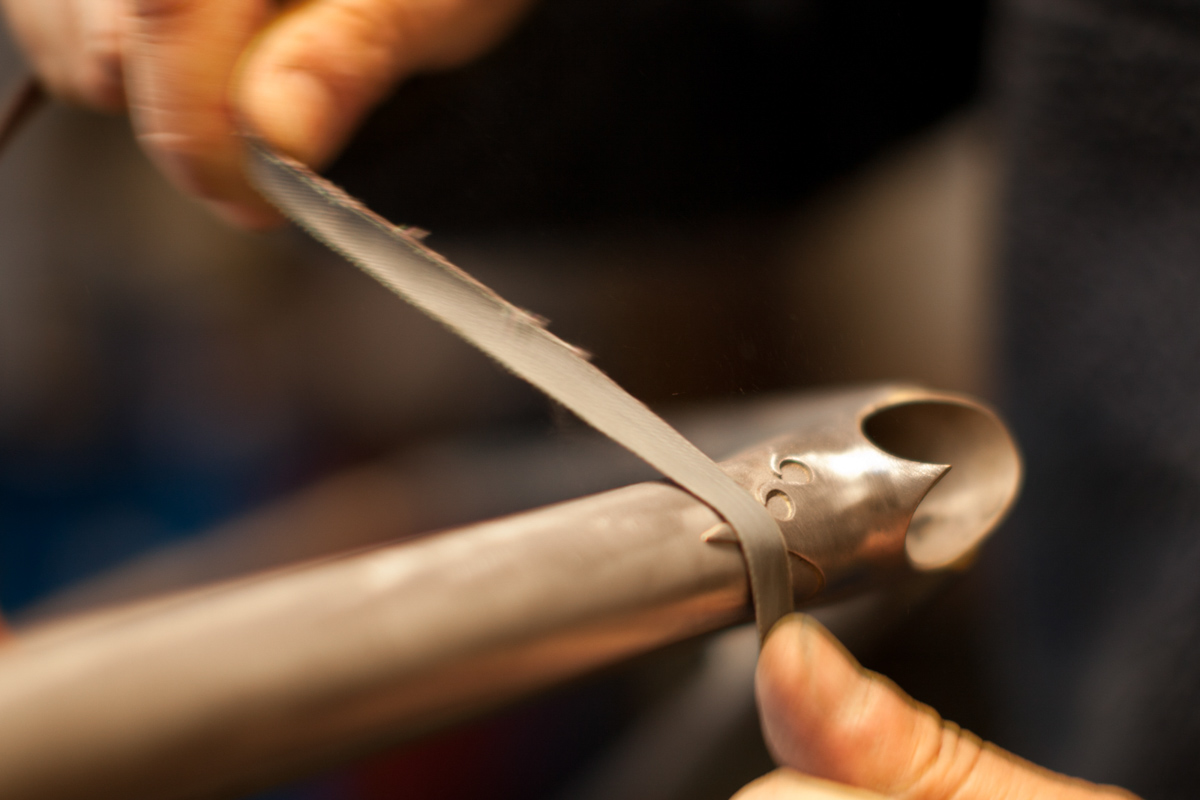
BIKERUMOR: Was it funny at the time?
BRUCE: No. I had never fired anybody. It was totally anti-everything I was thinking about. I stayed there for almost two years.
I was the Vice President of Eisentraut Bicycles Inc. My $27k bought me 33% share. But Albert said, “Oh, we’ll run it as though we are 50/50 partners. Within two years of being in business, we went from 60 bikes a year to 750. We bought a bunch of machines.
I came to the realization that if I had a good idea and Albert liked it, we did it. If I had a good idea and Albert didn’t like it, we didn’t do it. I was always going to be that person. On the 2nd of January of ‘76, I showed up and the door was open, the shop was there, and there was a guy sitting at Albert’s desk. I had no idea who he was. It was total mind-fuck kind of thing.
Finally, I realized it was Albert. He had shaved.
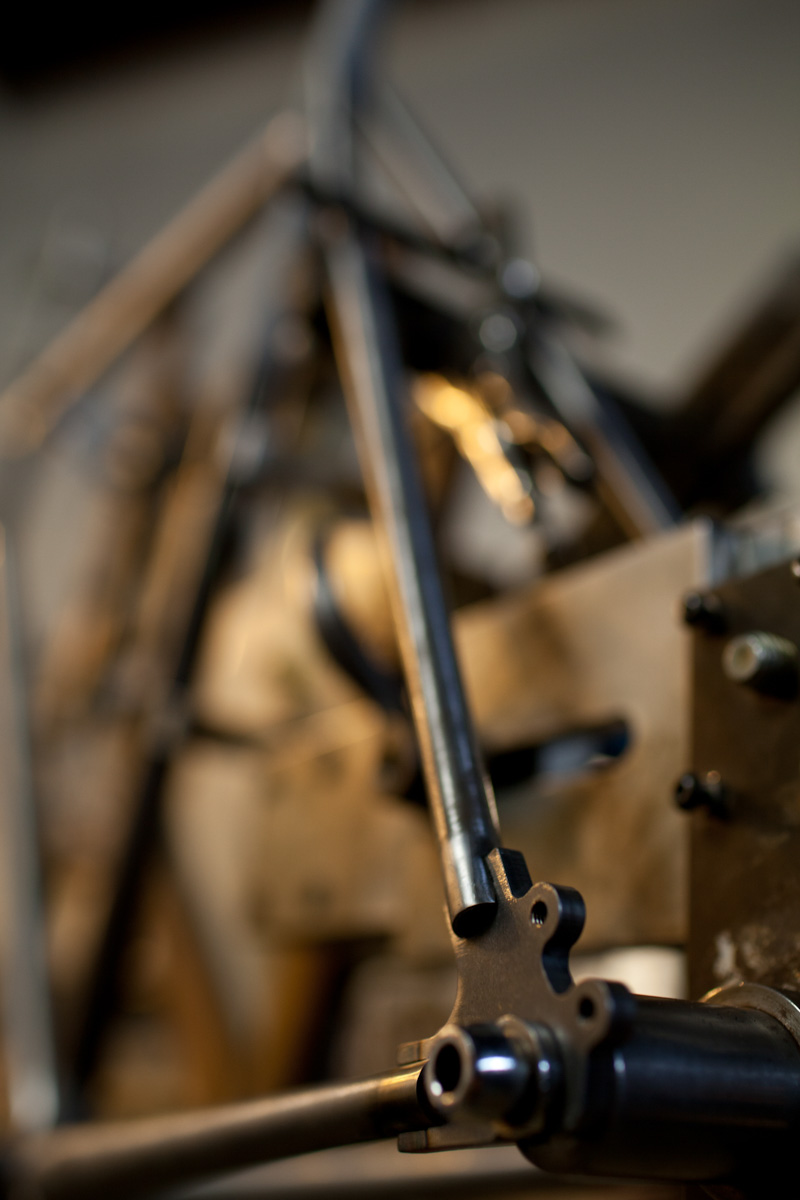
BIKERUMOR: It was business time.
BRUCE: Yeah. We agreed to split up. I said, “We’ve gone from 60 bikes a year to 750. We’ve grown this thing with my $27,000 dollars. I think perhaps, in two years, I’ve earned 10%.” I remember Albert saying to me, “It doesn’t matter what you think or I think, it’s what someone is going to pay for the business.” Albert changed the locks. I had invested all my money and I couldn’t get in the place.
BIKERUMOR: So he went home for the holidays and came back like this?
BRUCE: He went back to Chicago. Yes.
BIKERUMOR: Uffda.
BRUCE: I couldn’t go in the place. It was way before email and faxes and things. I had a lawyer in Oakland, who was a big time lawyer for the Raiders or the Warriors or whatever. Albert had what I call the sleazy guy. He was from San Francisco. They would write letters to each other. Six weeks went by. I’m sitting at home because I can’t get into the shop. Albert has the keys and is still writing himself checks.
BIKERUMOR: You needed cash to do something.
BRUCE: Yeah, I wanted to open a bike business.
It was a corporation so I had to find someone to buy the stock. After six weeks I got an offer that said when the corporation could afford to pay me back, they would pay me back at $14,000. I said, “No, there has to be a payment schedule.”
I went to a lawyer on a Friday. He said, “You can dissolve the corporation. Albert will end up with nothing. You will end up with nothing. And the lawyers will end up with money. Once you file the papers for disillusion, that’s it. It’s started.” I said, “Go for it, because I can’t sit at home thinking about this thing any longer. If I’m going to end up with no money, then Albert is going to end up with no money.”
BIKERUMOR: Wow. Whoa dude. That’s some spite engine shit right there.
BRUCE: Yeah, I’ve always been spiteful. I was sitting there and my lawyer called Albert’s lawyer. Albert’s lawyer was not in town, but he talked to a partner. It was interesting. Lawyers talking to each other aren’t adversaries. He was in the same law firm and said, “We’re going to file for dissolusion.” The other guy goes, “It sounds like you made up your mind.” “I think you owe it to your partner’s client to tell your client that it is happening at 9am on Monday morning.”
I was at home and someone slipped an envelope under the door that had another offer. Albert was paying me $300 a month and I was four or five months behind on my wages. Yeah, I would get $14,000 at $300 a month plus my back wages. I remember thinking: every month, the check would come a little bit later. By the end, it was two or three months behind. I remember thinking, “I don’t need the money terribly, but I know how pissed off Albert is writing this check every month.” We didn’t talk. He ended up paying me the $14,000 and my back wages of two years.
So I moved to Oregon and started my business with $14,000. That’s where Bruce Gordon started. With the $14,000, and my dad loaned me some money and I bought some machines and started Bruce Gordon Cycles with that.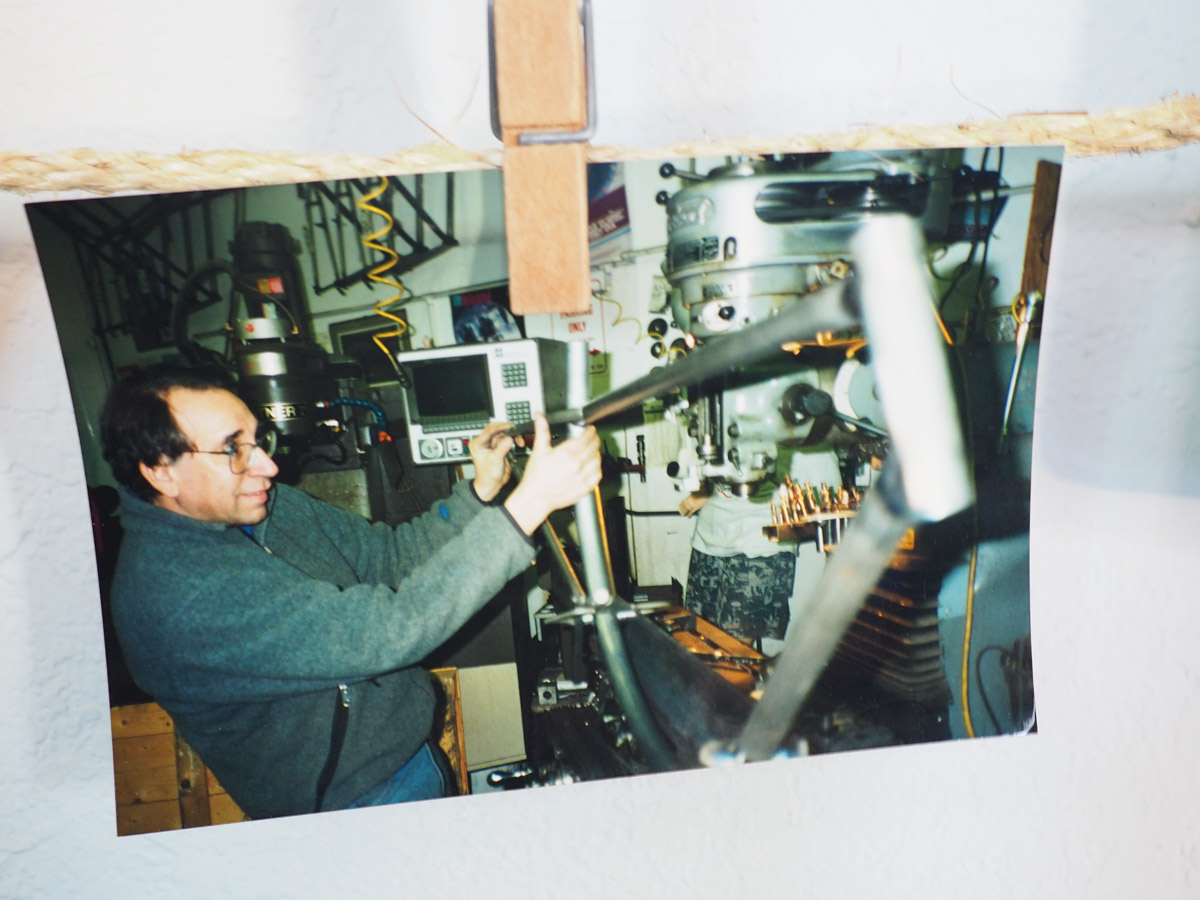
BIKERUMOR: Did you set out to build a specific type of bicycle when you started Bruce Gordon Cycles?
BRUCE: No, we made mostly lugged racing bikes. Albert and I had done the Limiteds, which was my name. It was a weird deal because they were actually the Unlimiteds, they were named after the Buicks, so we did a bunch of fun logos.
BIKERUMOR: Eisentrauts were racing bikes?
BRUCE: They were mostly racing bikes, but he also did custom bikes. When I moved to Oregon, I looked at the market and touring was a dirty little secret. I always said that if people went to a trade show and saw what the industry thought about touring bikes, they would find a different sport. Touring bikes were the dirty word. I ended up making touring racks because it was a market. There were a million people — well, there were maybe 30 or 40 people making racing bikes. So I made touring bikes. I’ve never really long distance toured because I’ve never really had time to do it. I’ve done some tours.
I started in ‘76 and moved to Oregon. Lived there for 12 years and made bikes. Ross Shafer — I was painting the Salsa stems. Ross Shafer would send them, I would get a box full of stems in the morning. I would powdercoat the stems and send them back the same day. It was a pretty quick turn around. I was friends with Ross and I would come down here. I thought, Wow, the weather is really great in February here. The weather is really good in November. It was ten degrees warmer than Oregon. It didn’t rain as much, and the rain fell straight down. It didn’t come at a 45 degree angle.
I decided to move back to Petaluma after twelve years. I was in the back of Ross’s shop, which was down on the river, a couple blocks. I wasn’t really happy there because it was below the Mexican restaurant that Sean [Walling of Soulcraft] was talking about last night. I was underneath the street part, and there was a brick archway — it was maybe 300 feet long and maybe 20 feet wide.
BIKERUMOR: Was it in a basement?
BRUCE: It was above ground, but it was a basement. It was a building from the 1860s. I was in the part that stone walls — they were grout. I would come in and there would be all sorts of gravel on my things. I wasn’t really happy. The air came from 300 feet away, went by this doorway to my shop — just in front of the doorway was the chop saw. All day I smelled that thing. I wasn’t happy. So I moved to what was two blocks away from my shop now, which was another place. Ross never understood my sense of humor…
BIKERUMOR: So you went from being in the same shop to being next door neighbors.
BRUCE: And not talking. I didn’t have a bathroom, so I would use — this is really funny — Ross had a bathroom in his space next door to mine. So I would go in there and use that.
I used to get a whole bunch of people who would come into the shop. “Is Ross here?” I would go “Ross who?” “Salsa Cycles?” “Do you see anything named Salsa in here? This is Bruce Gordon Cycles.”
I made a map with Corel Draw that took you from my shop, downtown, across the river, back across the river to 2nd Street to next door. I still have a copy of that. It was a hand drawn map.
BIKERUMOR: I bet Ross loved that.
BRUCE: I give credit to Ross — he made the effort to say, “Hey, let’s cut it out.” I’ve had feuds with a whole bunch of people. Yeah yeah yeah. So we’ve had a love hate relationship.
Ross got bought out by QBP. And I remember, we weren’t talking at that time, but we were sharing a wall. I remember sitting out and I’d say, “You know Ross feels pretty strongly about his brand. It isn’t his name on it like Bruce Gordon. But Salsa was his thing, with the pepper man.” I didn’t want to be around in six months when they had aluminum tig welded bullshit from Taiwan. It took less than six months. QBP said making stuff in Northern California was way too expensive. They bought the name. They bought the logo.
Before he sold, Sean mentioned yesterday, Ross made money from tshirts, from coffee mugs, from quick releases. They broke even on stems. Frames were a loss. He had a meeting and he spelled this out to all these people. Essentially it was like, “All the stuff you guys that you think is important… and we’re making money on quick releases.” That was one of the harsher moments.
BIKERUMOR: When was that acquisition?
BRUCE: ‘93? Maybe ‘94? I never knew how much money he got, but I don’t think it was a whole bunch of money.
Ross is extremely talented. Sean is extremely talented. We’re all weird in that we all have our quirks. And the bike business is full of crazy people. It’s like — when you think of Ross and Sean and Steve Potts and Jacquie Phelan and Charlie Cunningham. They are extremely creative people.
BIKERUMOR: Today, you’re doing touring bikes and racks exclusively?
BRUCE: Mostly. I did racing bikes. I would much rather do racing… I would much rather do track bikes. The reason why? There are fewer braze-ons. And then there are racing bikes which have a couple more for them. And then there are touring bikes, which have millions of braze-ons and crazy people dealing with them.
BIKERUMOR: Yep. That’s why the world loves making race bikes.
BRUCE: The industry is run by product managers. I remember in the early 70’s when Colnago and the Italian bikes in the Tour de France went over to chrome forks. I remember seeing the first one and thinking, “It’s too bad. This guy had this nice racing bike, and crashed it and bent his fork and all he could get is a chrome fork.” And then I realized that the team, they made it so that teams in the Tour de France rode those things so that people wanted chrome forks, when in actuality, the manufacturers wanted people to want the chrome forks, because they didn’t have to paint them. Say you had five colors and there were five lengths of steerers… that was 25 forks you had to have.
BIKERUMOR: But if you have a chrome fork, you don’t have to worry about matching paint.
BRUCE: Exactly.
BIKERUMOR: You deliberately avoided industry. “Big Industry.” But you haven’t stopped going to trade shows.
BRUCE: The trade shows are pretty much a social event. The reason why I show up at trade shows recently is so people don’t say that they think that I’m dead. “Did that fucker die and we didn’t hear about it? Did he [choke on a] pork chop? I heard rumors on the internet…” It’s a big social event because I don’t sell enough tires.
BIKERUMOR: When did you get into making tires? Why did you start making tires?
BRUCE: When I was in Oregon, maybe ‘81, I was friends with Jim Merz and Mark DiNucci and Andy Newlands. That was when Jim was just was beginning to work with Mike Sinyard on the mountain bike. One inch top tube with 66 degree head angle. “Ride this thing! It’s really cool! You can ride up and down curbs,” I distinctly remember, he told me. I came back from a ride— it was raining, it was horribly muddy. And I said, “Yeah, you can ride up and down curbs. Cool. You know? But it’s never going to take off.”
And so I was wrong about that.
BIKERUMOR: You were riding up and down curbs on this thing not believing it.
BRUCE: Yeah. Then — it’s sort of like in 1993 we went to Friedrichshafen — which turned into Eurobike. We were in the American Pavilion. There was Paragon and I. I showed up with two bikes, Paragon had a bunch of parts in a box. We had no display. I wish I had a picture of the display because we hunted and gathered some hay bales and some packing pallets and made a display out of that. It was like, we were in a foreign country, we had to do it.
BIKERUMOR: You get some cowboy hats?
BRUCE: That was afterwards.
We were in the American Pavilion with this company that made these backpacks that had a bladder in them, with a clear plastic thing that you clipped on. I walked up to them and said, “I sure hope you didn’t pay American money to come here.” It was Camelback. Recently, I think they sold for 470 millions dollars. I was wrong. I was wrong about the mountain bikes and the Camelbacks.
If I say something is never going to make it, I would invest in it ‘cause I’m the kiss of death.
BIKERUMOR: You were wrong on mountain bikes. And you shared space with people who built mountain bikes.
BRUCE: The tires… the tires… everything was 26in. Before then, up in Oregon, I built a few touring bikes, but mostly they were all 700c. Gary Helfrich is a Titanium guru from back East. He found a Finnish tire… it was a 700×45. I built a couple bikes around it and it was — I made the same comment which was like — the angle of attack on a bigger wheel is smaller. It is less. So it makes sense. The reason that I used to give was the same reason they made six foot diameter stagecoach wheels. It would have been much easier to make two foot diameter stagecoach wheels— but it wouldn’t have rolled over things as easy.
No one was ready for 700c. In ‘93, I called Rock Shox. I know I called Rock Shox, because I wanted the Mag 21’s with longer fork blades so I could run 700c. I remember — I think I talked to Paul Turner. If not, it was someone who worked for him. They told me, “No. It’s crazy. No one would ever ride a 700c mountain bike.”
So I was wrong about that again, you know?
Gary — Gary found these tires, we built a couple 700c bikes around them. Then we decided that we were going to have some tires made. I made it a little rounder. Joe Murray, famous bike racer Joe Murray, he ended up drawing the tires and that was in 1988 and it was pencil line technical drafting. I faxed it to Taiwan. You know, just the way things changed in 25 years, it’s like that. Joe did the drawing, he was my product manager for that.
I couldn’t give the tires away. Everyone rode 26in wheel mountain bike off-road tires.
When I had prototype tires made, Bianchi got a tire and they displayed I think the Project 7, or something in the late 80’s, early 90’s, Bill Horner was the product manager there. They had a bike with my tires on it at Interbike. They had a note that this was their new prototype tire, which pissed me off.
BIKERUMOR: It was branded Bruce Gordon? It was the original Rock n’ Road.
BRUCE: Yeah. Yeah. There was a millimeter or two clearance over the tire. I told him, “This is a prototype bike, this is a bike for a show. But obviously, you’ll make a longer fork, longer clearance.” And he said, “No. Well, you know about the import duty.” I said, “Yeah, I know about the import duty” because I was importing bikes—
BIKERUMOR: The import duty being the tire import duty?
BRUCE: The whole bike. No one was making bikes. The import duty as I understand it — if a bicycle had a tire wider than four centimeters, it was 11%. If a bicycle had a tire that was under four centimeters, then it was 5.5%. So it was 5.5% difference. It was designed to protect American made cruisers. Between Raleigh and Schwinn — that was my theory. Someone paid a congressman to protect American cruisers.
When Gary Fisher first started Fisher mountain bikes, the original Fisher mountain bikes would come with tires under four centimeters on them. They would open the box, throw in a set of mountain bike tires. That way, they got around the duty because the tires were under four centimeters when they were brought in. Then, they changed the tariff so that it said if a bicycle had clearance for a tire larger than four centimeters.
BIKERUMOR: When was that shift? Do you know?
BRUCE: It was ‘89? 90? Bill Horner said, “If we change a cable…” At that time, I was bringing in the Hikaris. They were a lugged bike from Japan. They were XT equipped. They were light, recreational bikes. I knew — they were $450 they cost me, for a whole bike. So it’s like, what’s 5% of that? $20 bucks. I said to them, “For $20, you’re not going to make a bike that’s as good as it can be but fits the tariff.” I remember when Bill Horner said to me “If we change a cable guide and it costs a quarter more, that is a board of directors meeting.”
People don’t know this about the bike business, but it is ruled by money. It’s ruled by product managers and bean counters. I was pretty pissed off at Bianchi about that, the note saying that it was their new prototype tire… and it didn’t have enough clearance.
I had a thousand tires made.
BIKERUMOR: How long did that first batch last you?
BRUCE: Pfft! Years. Five years ago, seven years ago maybe? Sean helped me build — when 29ers were the big thing. Okay, I’ll build a 29er. Sean does this so I got tubing from him. I put the big Schwalbe tires on them, it was more or less a city bike. It’s upstairs in my showroom. They were lousy. So I said, “You know, I have one set of Rockin Road tires that aren’t all krispy that are 25 years old.”
BIKERUMOR: You kept them in the vault!
BRUCE: Right. I put them on that bike and took it to the tradeshow and everybody loved it. It’s like, “Wow!” That was the impetus. But, you know Wes Williams from Willits who worked for Ibis. Remember the 700c shock fork? He built that and he built himself one… and he became a big proponent of 29er. He always gives me credit.
BIKERUMOR: You designed a 29er tire.
BRUCE: As I say, there were 29ers before 29ers were 29ers.
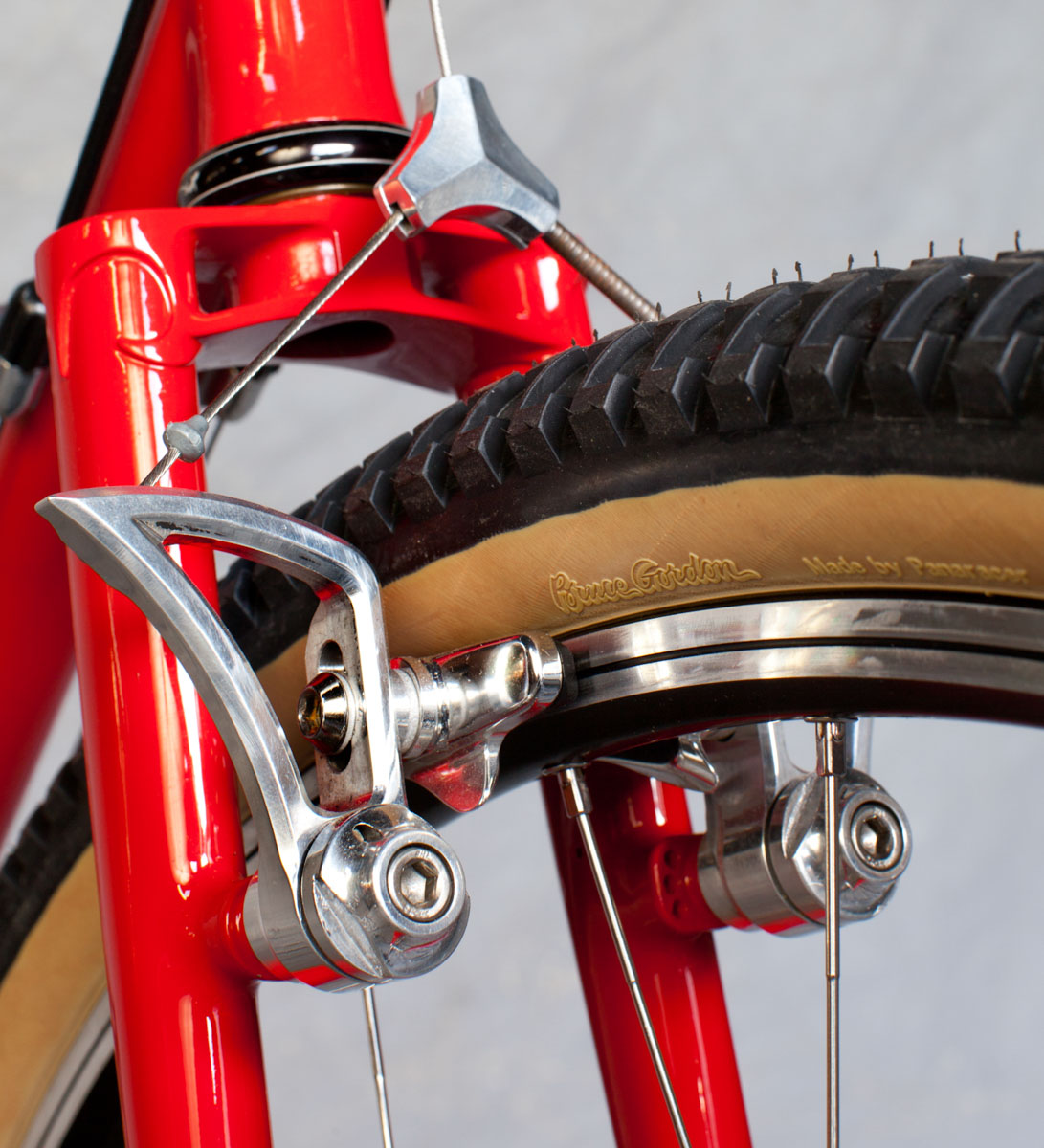
BIKERUMOR: So you did the godfather tire. What was it like in 2008 where everyone was like, “26 is dead!” You’ve had this. You were making these.
BRUCE: But they weren’t as big. 29ers were way big. They were bigger. They were wider. Mine was essentially monster cross or gravel grinder. We used to call them road bikes with fat tires. But marketin g— you have to have a name for it. “It’s a fat 700c tire.” That’s what I called it. But they came up with 29er and the gravel grinder and the monster cross and all these names. I ended up putting those tires on and I took it to a show, and everyone loved them.
I switched over to Panaracer because they made tires in Japan. The country of origin is really important to me. I never look at anything, I never buy anything, that I don’t look at the country of origin on. I’ve been in manufacturing my whole life.
I’ve been very conscious and as a result, when I called I talked to Jeff Zell from Panaracer. Panaracer has three factories. They have a factory in Japan where their best tires are made. China is second. And there is a place cheaper than China, which is Thailand.
“Just for shits and giggles, tell me what the same tire going to cost…” because the molds were specific to the country. “I’m only interested in Japanese tires. But how much is the same tire going to cost me.” It was a $1.80 per tire less. I said, “Why would anyone in their right mind have the tire made in Thailand when for $2 more…” He said to me, “$2 becomes $20 retail.” That’s the way product managers and bean counters think. It’s the difference between a $50 tire and a $70 tire. What I’m doing is a tire for $52 without shipping. The trouble I have is that people are comparing it to a $50 tire at Mike’s Bikes. There is a vast difference because I’m eliminating one of the middle men. I always say, if I wanted a table made, I would go to a guy that made tables. I wouldn’t go to Ikea.
BIKERUMOR: Or you would make the table.
BRUCE: Or I would make the table. And the other story that I tell all the time to people is like, I’ve been at this for over forty years. In the forty years, there’s been many, many improvements. Shock forks — before that, there were motorcycles with shock forks, but nobody ever made a bicycle shock fork… they did, but turn of the century. Salsa made TIG welded stems. No one did that before. Phil Wood made sealed bearing hubs. No one did that before. All these things were made in three or four person shops.
The Taiwanese or the Chinese — if we were to wait for them to come up with the mountain bike, we would still be waiting. They can fabricate stuff.
My point is, you should support the people that think of this stuff.
BIKERUMOR: Rather than wait for companies that figure it out to make it, for that product to be safe space.
BRUCE: Yeah. That’s the drift of the thing. I’ve spent my whole career trying to make stuff cheaper. The only way to make stuff cheaper is to eliminate the middlemen. I sell tires direct to dealers, but I don’t sell them to Quality, who sells them to dealers. I’ve sent a whole bunch of tires to people who work for Quality. I say, “Please don’t copy my tires.” If QBP comes out with a $50 tire retail? It’s going to be a tire made in Taiwan or Thailand, it’s going to be a shittier tire.
I sell a lot of them in Europe to shops. You can’t buy them on the store. I have to figure out the freight for Europe. I’m not an Engineer. Quality and Specialized have these “tire engineers.” It’s like: bullshit. My tires are from before they had directions on tires. I get a whole bunch of people who call me and say “there’s no direction arrow on the tire.” I always put them on so that the label is on the right side. If you find that putting them — Sean actually put the back one reversed. If you find that it works better, call me and let me know. I can’t do that.
It somewhat bothers me that I’m making my money off of tires. But, I designed it.
BIKERUMOR: Cause you’re a founding member of SOPWAMTOS (Society of People Who Actually Make Their Own Shit).
BRUCE: Yeah. The storefront that I want to start, I kiddingly say to people in the industry, is the anti-Velo Orange store. I want to sell stuff where — and I’m not xenophobic, it can be Japanese or Italian — I want to sell stuff where the name of the factory is the same as the name on the product. There is no Velo Orange factory. There is a Honjo factory. Their fenders are world’s better… and that’s an important thing. There is a Nitto factory. There is not a Soma handlebar factory. I’m trying to eliminate the middlemen and sell the good stuff.
I don’t fit in the bike business.
BIKERUMOR: Let’s discuss SOPWAMTOS as a concept. It re-manifested for the first time in ten years at NAHBS. I think it is an important concept.
BRUCE: It is!
BIKERUMOR: I don’t think people understand the world it was created in.
BRUCE: SOPWAMPTOS started — Mark Norstad and I went to Eurobike, the precursor to Eurobike. When we were on our way back, we were thinking, “You know? Joe Breeze and Tom Ritchey? They get flown to Friedrichshafen. They get picked up from the airport in a Mercedes. They sign autographs for two days. They get driven to the airport and they fly home. We were the CEOs of our own company. We made all the shit. We flew in all the shit. We made the display. We manned the display. Four days later, we were going to Las Vegas after we came back. On the way back, we founded SOPWAMTOS.
This was ‘93. It was tongue in cheek. It was a funny, stupid thing. It was all about country of origin and actually making shit as opposed to causing shit to be made— which I’m not poo-pooing. But, it’s a difference.
The first year, I don’t think we did tshirts. The second year, we did an award ceremony. That was when David Falco was working for Recycle Town at the landfill. “SOPWAMTOS is the Society Of People Who Make Their Own Shit, so let’s give away toilet seats. I can get you as many used toilet seats as you want.”
We used to get toilet seats from the dump. We used to hose them off. That was it. We’d spray paint them gold and letter them and give them away.
BIKERUMOR: Wow. That’s so literal!
BRUCE: Yeah! They were toilet seats from the dump! Sean did it one year, five or seven years ago. I said, “Are you going to do it again?” He said, “It’s a lot of work!” “Yeah, it’s a lot of work.” “I’m not going to do it again.” That was the year of the Cannondale fist award. Cannondale had a big rubber arm which he made into a trophy. I think someone picked it up and put this in the trash. This last year at NAHBS in Sacramento, Robert Ives wanted to do it.
Robert decided that it should be at Interbike as opposed to NAHBS because it is more industry stuff.
The third year we had the hula hoop girls. We wore our fezes. We were wheeled down the aisles. Someone came up and said “You can’t do this! You’re causing a thing!”
All the decisions were made at Dempseys. I still have all the cocktail napkins that we made our decisions.
BIKERUMOR: So Mark comes up here, you have beers, and —
BRUCE: We would think of who deserved an award. Second step was: what award do we give them? Third step was: who are we going to nominate that won’t get the award? In the archives, it’s on my desk, is all the cocktail napkins, all the lists, and all the awards. The second year… we gave the “Smoke and Mirrors” award to Cannondale for the pong bike. Remember the pong bike? The CNC machined bike? Remember the skateboard wheel bike? That was the second year. Scott Montgamery was the president. He would send me Christmas cards thanking me, said that he hung those toilet seats proudly on his wall in his office.
BIKERUMOR: Did he get it?
BRUCE: Yeah, I think he got it. Yeah.
BIKERUMOR: Cannondale was still making their product domestically at the time, though.
BRUCE: But they were making smoke and mirrors shit that wasn’t available. The first year we gave toilet seats, we had the best R and D award, “Rip off and Duplicate.” That went to Specialized. I ran into Mike Sinyard in an elevator after the award ceremony. I said, “I think you got an award.” “What was it?” “I’m not going to tell you. Send somebody to the booth to pick it up. But I think that you got one.” I knew that he got one. I saw him a few days later. “Did someone pick up that award?” “What award?” And he turned around and walked away. He didn’t talk to me for ten years. Since then, we’ve talked. I’ve run into him at one of the handbuilt shows, at San Jose. He was like ten feet away and he was smiling and laughing and talking to somebody. He said, “Are you still in Oregon? You’re still in Oregon aren’t you.” “No, I moved 25 years ago.” “Oh! You moved!” “I’m in Petaluma.” “Wow, that’s Bay Area! We should have you do some design work or something!” “No.” That’s where the excellence in litigation award, the grand prize, came from Specialized.
The bike business used to be more fun. I’ve been saying for years, no one makes nearly enough money doing what they do, so you might as well have fun with it.
BIKERUMOR: You did make mountain bikes for awhile.
BRUCE: I’ve made maybe ten or fifteen mountain bikes.
BIKERUMOR: How many bikes do you think you’ve made total?
BRUCE: Two, three thousand? Somewhere between two and three thousand.
BIKERUMOR: What about the Hikaris?
BRUCE: They were a cast lug — my first foray into Japan. I learned my lesson on that. The Hikaris were recreational bikes. They had racks, but they weren’t full blown touring bikes. The Rock n’ Roads that had Bruce Gordon stickers on them, those were made in Japan. I ended up hearing “All Bruce Gordon bikes are made in Taiwan.” Then I had all the Bruce Gordon’s made at my factory. The rest would say “designed by Bruce Gordon.”
The Hikaris… I went to the factory, I told them I wanted “Made in Japan” underneath the clear so you couldn’t peel it off. I also told them I wanted on the bottom bracket, all the tubes mitered full. They said, “Why?” “Cause that’s the way I do things.” Their answer to that was, “For the same amount of money, we could paint the headtube a different color.”
BIKERUMOR: And you were like, “Nah.”
BRUCE: Yeah.
BIKERUMOR: Why have a bike line made in Japan?
BRUCE: To bring the cost down.
BIKERUMOR: Expand your income? Your impact?
BRUCE: Hopefully. It didn’t work out that way. There were only 100 Hikaris. Maybe 200. The Rock n Road became a TIG welded bike. The Bruce Gordon Rock n Roads are very rare. Only about 100 made. They became the “BLTs.” I decided that all bikes that said “Bruce Gordon” on the downtube were going to be made in California in my shop.
I designed the BLTs… they were going to be the same thing. I couldn’t give em away. The Taiwanese ones, that was a third effort. That was a nightmare.
I would rather sell 100 tires than sell one bike.
BIKERUMOR: It’s less work on your part.
BRUCE: I’m 68 years old. I’ve done it. I don’t have to prove it to anybody. I’m secure enough in my masculinity that I was pretty good at doing stuff, I’m not as good as I used to be. The L’Eroica, that’s a later thing. There is a guy that shows up on the internet. It’s a bike I built in the 70’s. He’s had it repainted, there are pictures all over the internet. He rode it in the L’Eroica. Paul and I had gone down for that. He ended up coming up to Petaluma and said to me, “Do you have any souvenirs?” “Souvenirs?” He ended up buying two water bottles. $10. “Mine is one of the good old ones because Bruce Gordon doesn’t make them anymore.”
Fuck you. I made this stuff. Do I make the entire thing? No. As I said, I wouldn’t ride a bike to the mailbox that I welded. I’m not a welder. When the welder comes in, the only thing that I do is that I drop the dropout on the chainstay so I can miter them and they weld the rest of it.
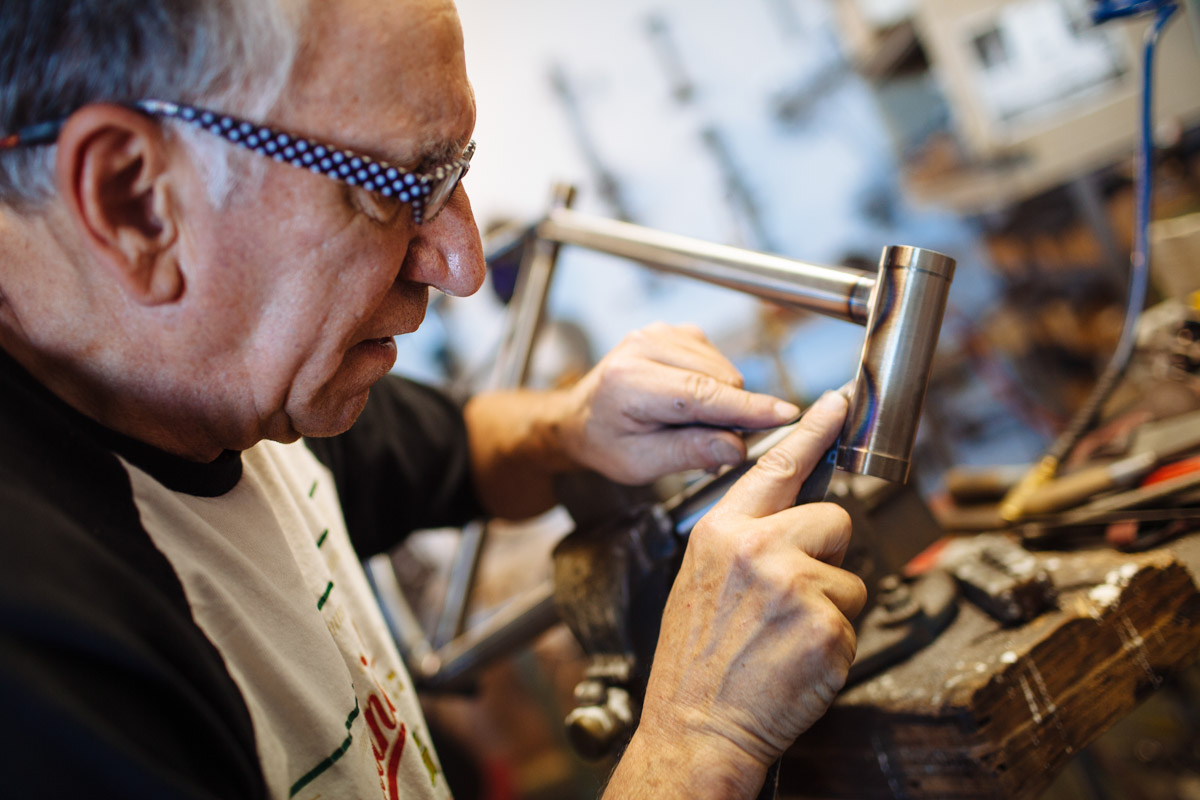
One welder comes and he says, “I can always tell when you’re welding. Number one, there’s nose prints on the inside of the screen. Two, the tungsten looks like a metal q-tip…” because I have all sorts of steel on it.
Would you ask Mr. Colnago, Mr. Cinelli? No! It’s made in my factory. I do way more work on my bikes than those guys, who are deified.
BIKERUMOR: You’ve got these brands like Colnago and Cinelli where their founders are deified without building. And then you have this culture of small builders in the US where it is one person, slaving away in poverty, spending 300 hours polishing a headtube in the shop by themselves.
BRUCE: Yep. Do you know why Brian Bayliss died? Pneumonia because he didn’t have health insurance. No one dies of pneumonia in your 60’s anymore. You go to the doctor if you have health insurance, you get a $10 prescription. It’s fixed. He waited too long.
I was thinking that if I was French, I would be a Constructeur. I’ve made tail lights. I’ve made handlebars. I’ve made seatposts. I’ve made racks. I’ve made brakes. I’ve made cranks. I’ve made panniers. If anyone qualifies as an American Constructeur, it’s me. I’ve made a whole range of things. I can’t call myself a bicycle Constructeur. Someone else can call me that. I can’t.
The brakes for example, I was building a lugged randonneur bike for a guy for one of the shows. The brakes — there were Shimano brakes, there were Paul brakes… they didn’t fit on the bike. I made a couple different versions of the titanium ones. The Shimano ones worked fine, so I measured from the post to the pad, from the post to the anchor. Came up with a triangle, and made them. I improved upon the PAUL ones a little bit — that mine have a bronze bushing in them that was pressed in that could be replaced. The PAUL ones run on a stainless steel thing that fits over the cantilever post. If you get a piece of grit, it galls the aluminum up.
But basically, I can’t think of the last time I sold those parts. I’m not going to make anymore.
BIKERUMOR: There is a list of stuff that Bruce Gordon won’t do. The Schnozola stuff, however, is an exception to those rules.
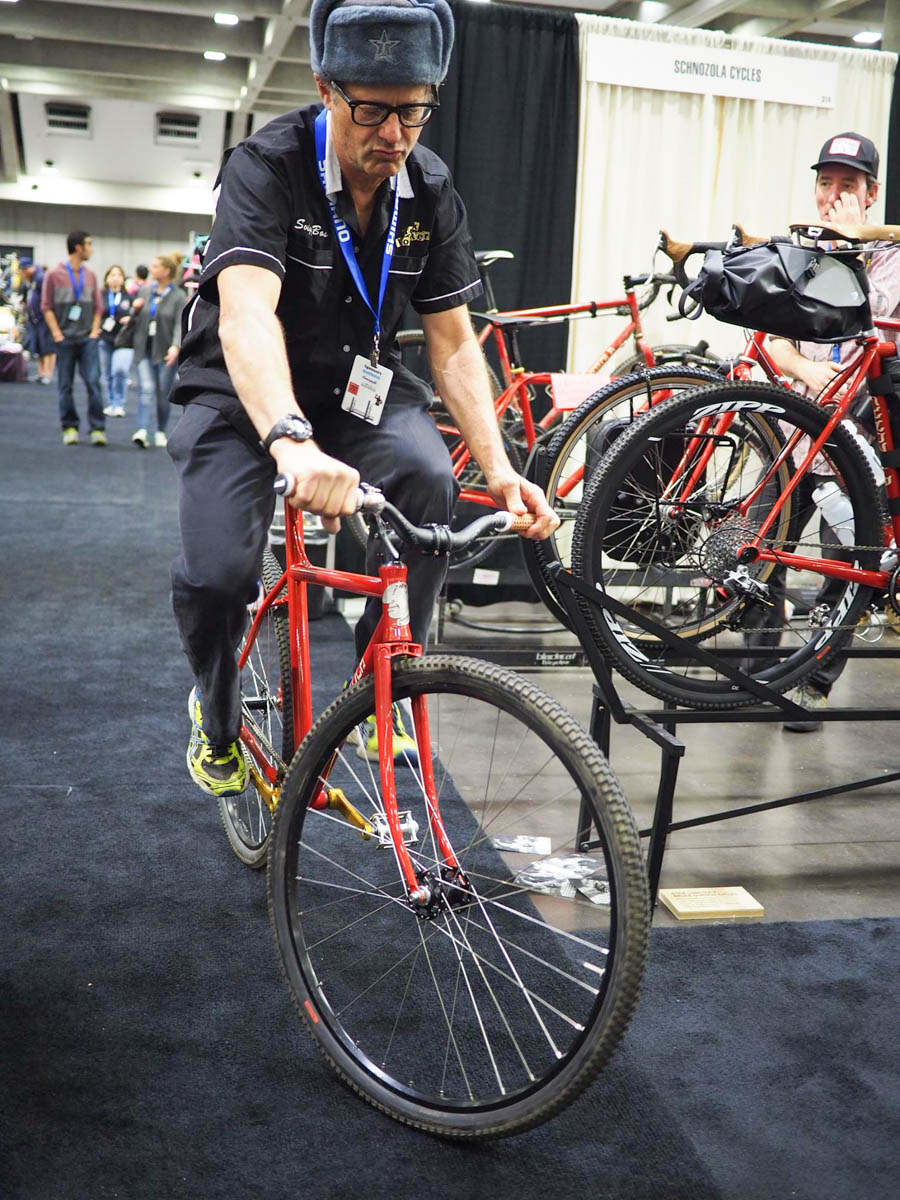
BRUCE: But that’s a collaboration between me and Paul Sadoff.
BIKERUMOR: You won’t do thru axles.
BRUCE: No. There are just some things that I won’t do.
BIKERUMOR: You’re done.
BRUCE: Yep. I’ve built enough bikes. If that’s what stands in the way of me building more bikes. I won’t build more bikes.
BIKERUMOR: So I’ve talked about Schnozola from Paul’s perspective because he was stalking you as a fan for years. He is one of many domestic builders I’ve talked to who credit you for getting you into framebuilding, for setting a standard. “I’m going to do that too.” Bilenky and Paul Sadoff both said that.
BRUCE: Bilenky — I hadn’t heard about that, but I’m humbled by that. The Paul Sadoff thing… I don’t understand why we’re doing it. But all I do — I powdercoat them red. They are all red. And they all have my tires. Other than that…
BIKERUMOR: There is no design commonality.

BRUCE: Except for the red paint. You want a blue one? You gotta buy a red one and strip it down. There are five Schnozola’s in the world. Three of them are sold. The first one was sold to Jeff Traugott, his neighbor who makes guitars.
BIKERUMOR: I think it’s really sweet. The bikes are interesting. I love the branding. Considering that you’ve made a career out of making statements, this bike is a statement. You aren’t enjoying that aspect of it?
BRUCE: I am enjoying it. When we had the booth at Sacramento…
BIKERUMOR: The Klezmer music! The same six songs blasting on repeat— off a cassette tape!
BRUCE: Off a cassette tape. Yeah that was all Paul.
BIKERUMOR: Handing out yarmulkes.
BRUCE: We were selling them! People came by the booth… it was more schtick than interesting stuff. Paul and I have made plenty of fancy bikes, well, I have. The bikes at the show were bikes that people ride. They weren’t show bikes. As a result, we haven’t sold any. If we sell these other two, maybe make some more. If not, there might be five of them.
BIKERUMOR: Relatively, a lot of hype for the brand, though.
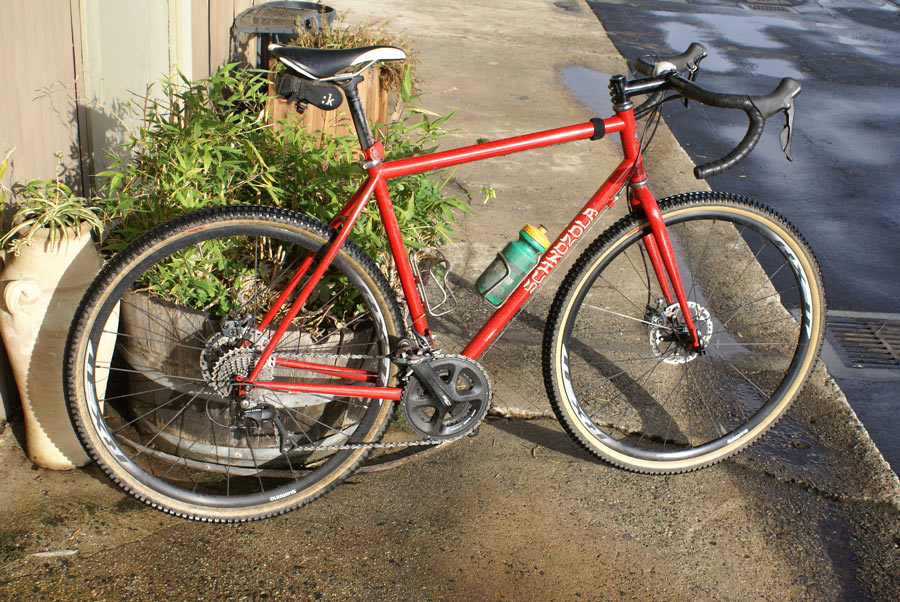
BRUCE: Thank you. Have I told you the story behind the logo? I found this font that was Hebraic in nature. It was $20. I took Schnoz 1 down to Santa Cruz. I had powdercoated it red. I stayed with Paul overnight. We went out to dinner. I said, “You know, we’re going to have to come up with a logo. Let’s just buy this font.” He says, “$20… that’s a lot of money! I can do it for less.” “$20, let’s just buy it!” “We just need some of the letters, we don’t need the whole alphabet!”
Turns out Paul had done calligraphy when he was in college. He’d designed that logo in about thirty minutes. Just drew it out. It’s still — he has it scanned from a pen ink drawing.
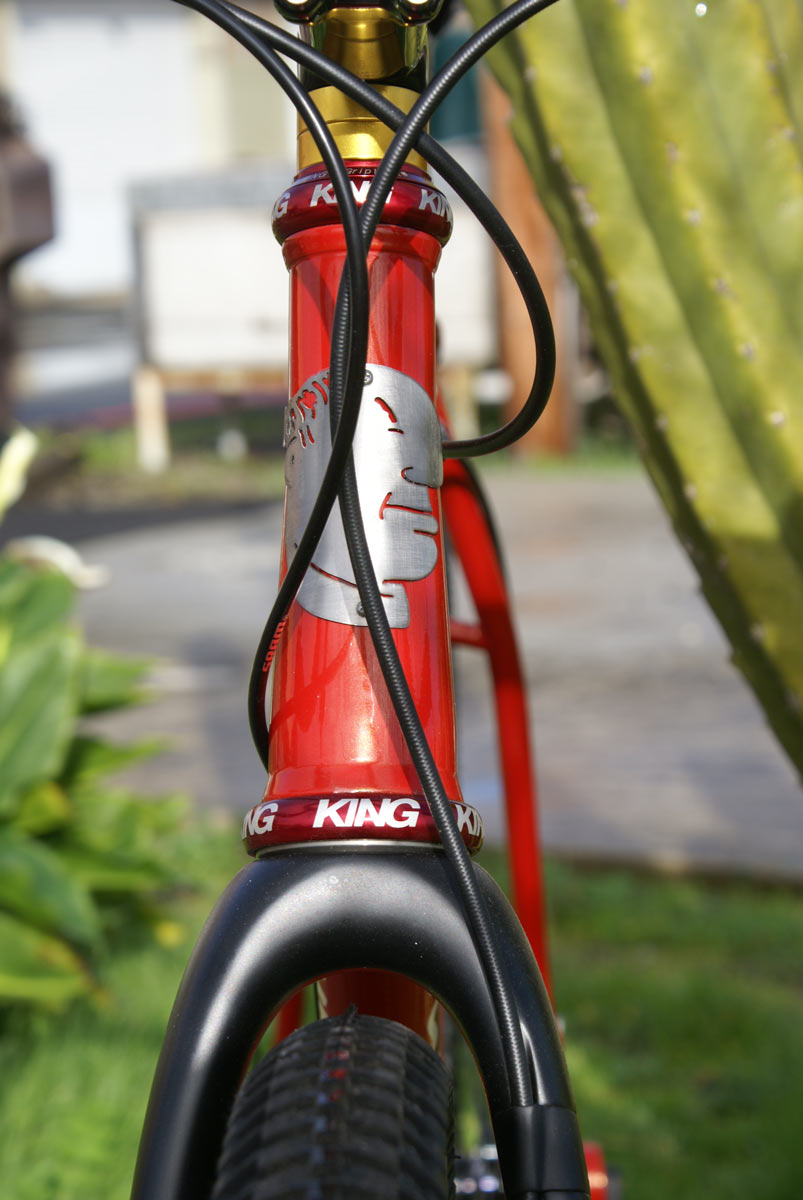
The headbadge is his father, Sydney with the big nose. That also doesn’t exist in a drawing form.
BIKERUMOR: What is actually the state of your operation right now?
BRUCE: What is the state? I make all the stuff. I make stuff as people order it. I used to do stock racks. I used to have a bunch of racks in stock. I used to have a whole bunch of bikes in stock. Now I just make em one at a time.
BIKERUMOR: You have some in production.
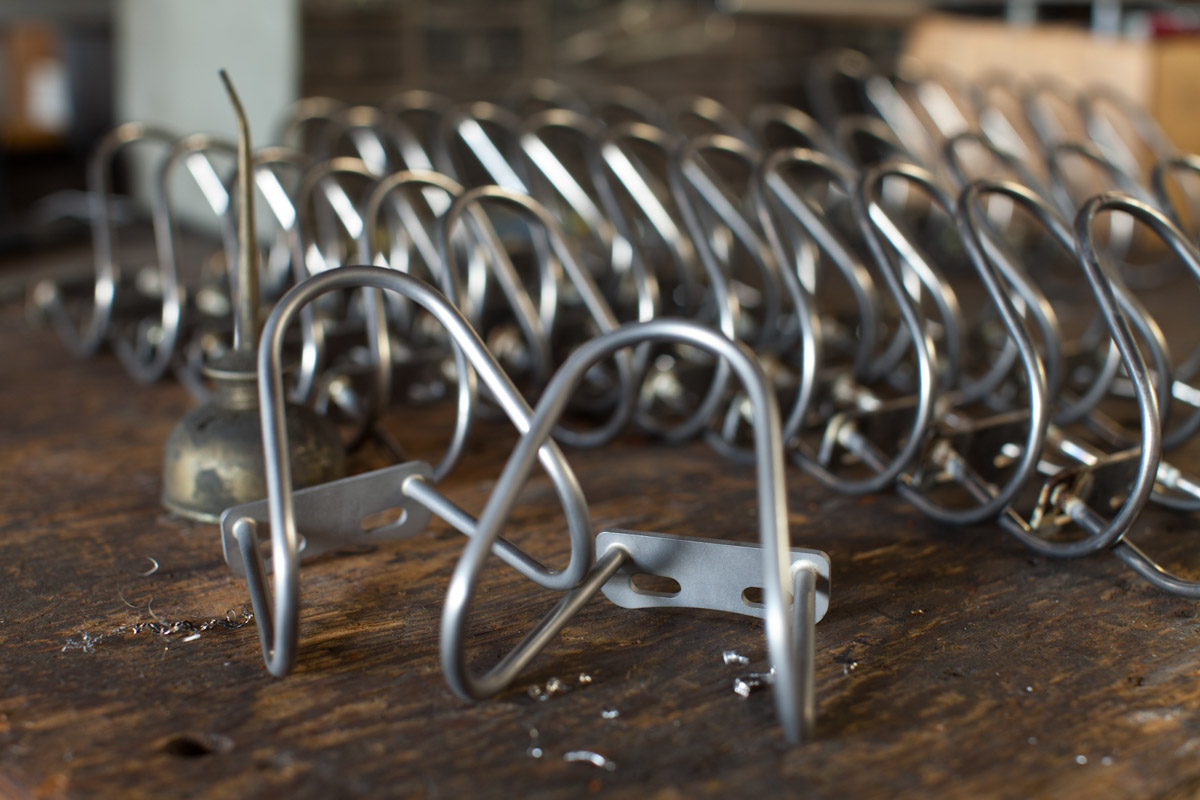
BRUCE: A few. They aren’t made up. They aren’t finished yet. And toe clips. I try to sell everything that people buy, I try to send out right away. Like the tires — boom. An order comes in from PayPal, I pack em up and ship em out the same day. Bikes, eh. Two or three months delivery time. That’s one of the hardest things. I had one guy who called me about a bike. I told him two or three months. And he called me three weeks later. I couldn’t deliver it in that. He yelled at me for forty—five minutes on the phone. “You’re a sleezy businessman in three months and now you’re saying you can’t do it. I’ve bought tickets to France and you’ve ruined my trip to France.” Well, when you order it and you put a deposit down, you get a date. Until then, it is an estimate. That’s the most difficult thing I have to deal with, is the customers.
BIKERUMOR: Considering… two or three months from a domestic builder? When you’ve got people with 30 year waitlists?
BRUCE: Exactly. My theory is — it’s a few years old, but Richard Sachs and Vanilla used to have this competition going as to who was the best in the world. The best in the world was the one with the longest waitlist.
BIKERUMOR: Paul wrote something hilarious about that.
BRUCE: Paul is making a hundred bikes a year. A hundred bikes this year. He makes two or three a week.
BIKERUMOR: With no one working with him.
BRUCE: Yeah. And they are all different. They are aluminum. They are steel. They are all custom. He has a list of thirty or forty people. I don’t know what the Schnozola’s are. They are maybe $50 or $75 cheaper? So why not? I don’t know why we are doing them except that Paul wants to do them.
But he’s really prolific. He makes a lot of shit. They are all these materials, standards. All these parts. I talk to him three, four times a week. He works really hard. He’s always there. He’s always making stuff. It’s impressive. I stand in awe of the people, you know.
BIKERUMOR: You’ve personally experienced over the duration of your career — you were part of one wave, and then there were two pretty significant waves of framebuilders after you.
BRUCE: When I started, when Albert and I started, I would venture a guess that there were twenty to thirty people in this country building bikes. In the early 70’s… Richard Sachs, Ben Serotta.
BIKERUMOR: Building for themselves somewhere. Because when you started, there were still significantly sized domestic bike factories.
BRUCE: Oh yeah. I’m talking custom shops. But nowadays, there are probably two or three-thousand framebuilders. As I always say — I’m not threatened by them, but if each of them takes two three orders away from a person who really knows what they are doing and who has been doing commercially for a living, that’s how I’ve gone from a hundred bikes to five.
My 95 year old mother wants me to sell everything.
BIKERUMOR: But you don’t want to be that guy.
BRUCE: I just don’t want to be that guy. I don’t want to be that guy.
BIKERUMOR: The 68 year old guy in the back of the room —
BRUCE: Watching people paw through your stuff and saying, “You want a buck for that… will you take ten cents?” You know?
BIKERUMOR: My terminal question every time is, “What do you tell the kid who wants to be the next Bruce Gordon?”
BRUCE: I wouldn’t recommend it.
BIKERUMOR: You wouldn’t recommend it? What would you tell them?
BRUCE: I have a whole bunch of people go, “Well, you know you’re Bruce Gordon.” I say, “Can you TIG weld? Can you TIG weld light steel tubing? Okay, that’s one thing you oughta learn. Two, you oughta learn how to do CAD drawing. Three, you oughta learn how to run a CNC machine. If you can do those three things, you can walk into any place that makes anything, and get a job. And then if you want to build bikes in your garage, be my guest. It’s a piece of cake.
Learn to be a welder, because there is a real shortage of welders. And it’s like, you can almost write your own ticket. But you have a limited timeframe. Like Eric Baar? He’s a spectacular welder, but he’s not going to be 30 years from now.
BIKERUMOR: There is a time limit.
BRUCE: ‘Cause you make money with putting your hood down. You don’t get paid with your hood up.
So, to the person who wants to be the next Bruce Gordon… I don’t know. I’m the wrong person to ask.
BIKERUMOR: Well, okay. End scene.
BRUCE: End scene.
